| There is a book 'TELEGRAPH and TELEPHONE Stamps of the World, a Priced and Annotated Catalogue' by S.E.R Hiscocks (1982) that I have used for information and catalogue designations, copies are in short supply. He catalogues stamps intended for telegraph and telephone use without regard of the cancel used. I on the other hand, want to identify items used with British Army cancellations (though sometimes this may have been postally). This page is about 'Non-British' stamps that were used telegraphically by British forces. Where I am reasonably certain that a stamp exists with Army Telegraph cancellations but cannot illustrate one, I will illustrate with a mint or otherwise cancelled copy, giving Hiscocks designations. |
Prices quoted are guided by eBay prices, John Barefoot prices and even Scott. Prices are for 'average' condition. The currency is now selectable, the default is British Currency (£). Used prices are for stamps with appropriate cancels. For the Cape of Good Hope stamps, this means pen cancels. For all others it means specifically with 'Army Telegraph' or 'Army Signals' cancels, with a premium for legible telegraph code and date. Setup |
The Langmead & Huggins book covers the use of these in Cape of Good Hope and a series of Sudan stamps,
but the British Army Telegraphs units operated in many other countries using local stamps.
| Shortcuts to different sections | ||||||||||
| Bechuanaland 1884-5 | Bechuanaland 1900 | Boer War | OFS / ORC | ZAR / Transvaal | Nigeria | G. E. A. | Egypt | Sudan | Palestine | References. |
| Newly added : This is a similar table for the Army Signals codes. It is largely based on a list created by Andrew Higson of the codes used in World War I, but with a few additions. Currently there are few images but extensive comments. For this to get off the ground I really need more images, preferably with information, but that can follow later. |
Military operations in Bechuanaland from January 1885 prompted the production of overprinted unappropriated types .
These had been produced for earlier use in Egypt and the Sudan.
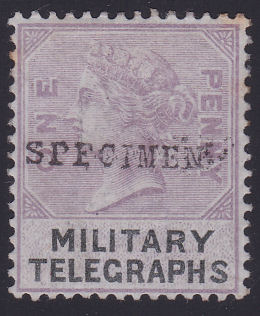
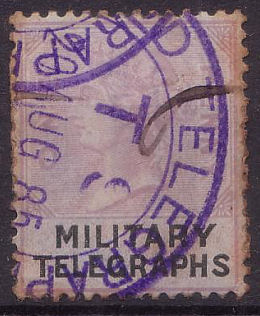
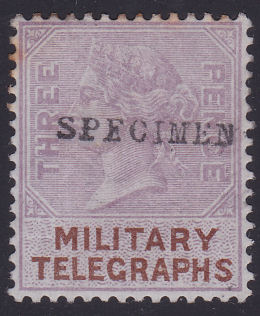
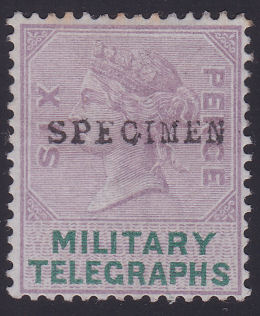
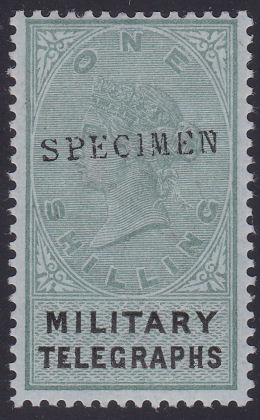
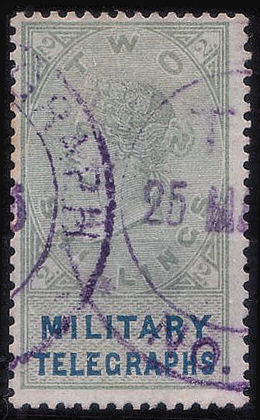
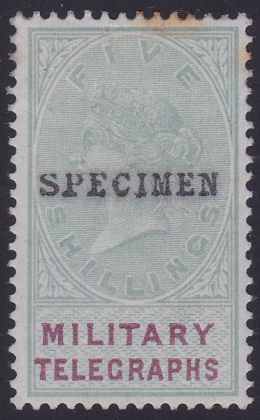
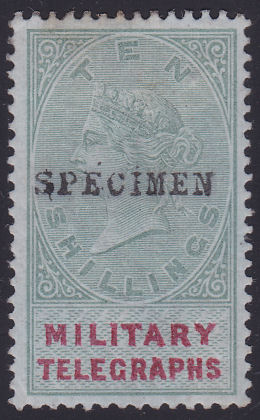
A selection of my specimens and two used examples courtesy of Steve Lawry that were used in Taungs. There was also a larger £1 value. Further details on Page 1.
A Military Telegram from Mafeking to Setlagoli, Bechuanaland 14 July 1885 showing the type of cancel that was used on these.
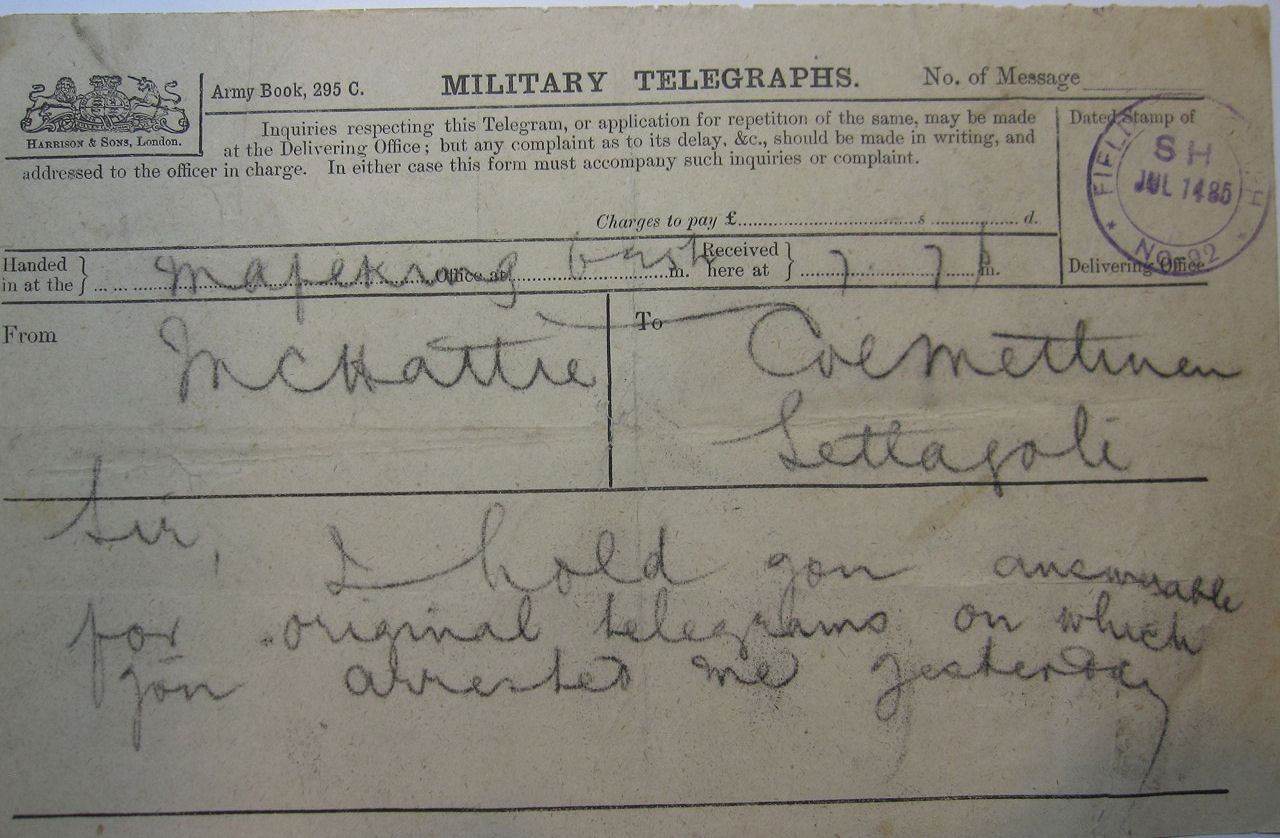
This is illustrated by L & H (Fig171, page 95) - Courtesy of Mark Gibson.
Subsequently, stamps of the Cape of Good Hope were overprinted to fill the gap.
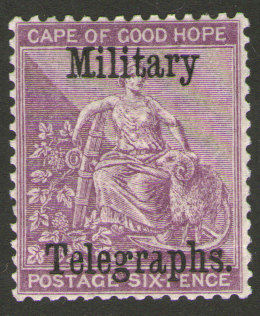 |
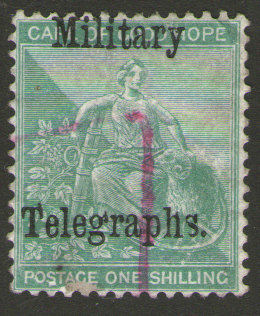 |
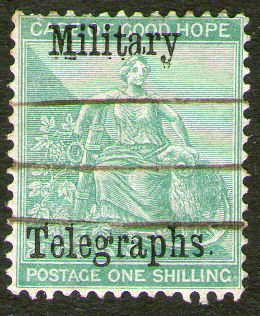 |
| GB-H9 | GB-H10 | GB-H10 with 'MILITARY' doubled |
Langmead & Huggins (page 95) mentions the 6d (Wmk: Cabled Anchor) and 1s (Wmk: Crown over CC) of Cape of Good Hope being used after September 1885 in Bechuanaland by British forces,
but I have not yet found any with clearly British cancellations. The first one shilling is cancelled with what looks like a censor mark, but they are mostly cancelled with initials, the date, or simply a stroke of the pen.
More images of these can be seen on the www.cghstamps.com website with a direct link to the military telegraphs at www.cghstamps.com/R35.html
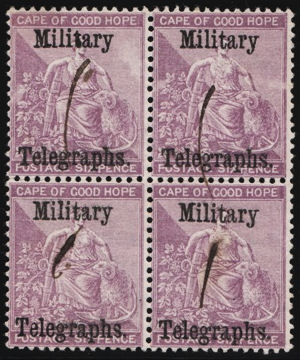 |
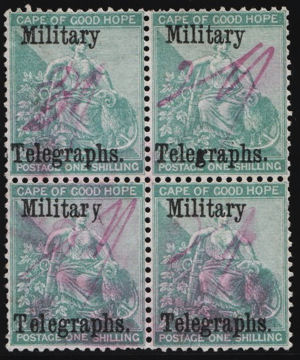 |
| Used block of 4 GB-H9 'l' in 'Military' missing serif on top-left stamp. | Used block of 4 GB-H10 Broken 'y' in 'Military' bottom-left stamp. Blind 'g' of 'Telegraphs' top-right stamp. |
| Images showing typical cancellations courtesy of Rene Gerritsen. | |
Hiscocks lists the variety 'Telegraphs' over 'Military' for the 6d, but it also exists on the 1/- value.
It appears to be the result of a vertical shift in the overprint.
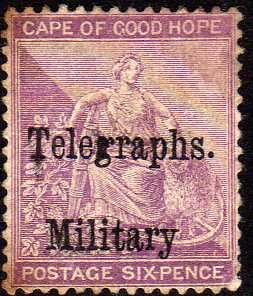
This image and the one below are courtesy of Andrew Higson.

These appear to have been used at least until April 1886.
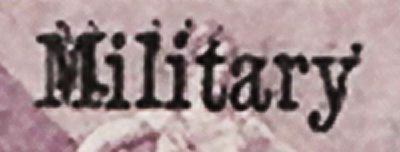 'Military' doubled - courtesy of Rene Gerritsen. And one of mine (shown above) on 1s 
|
Anyone have any ideas on this postmark?
Cape postmarks normally have the number in a box. This looks like a rather ornate '65' without box and reminds me of the Natal type.
Comments welcome.
A selection of these.
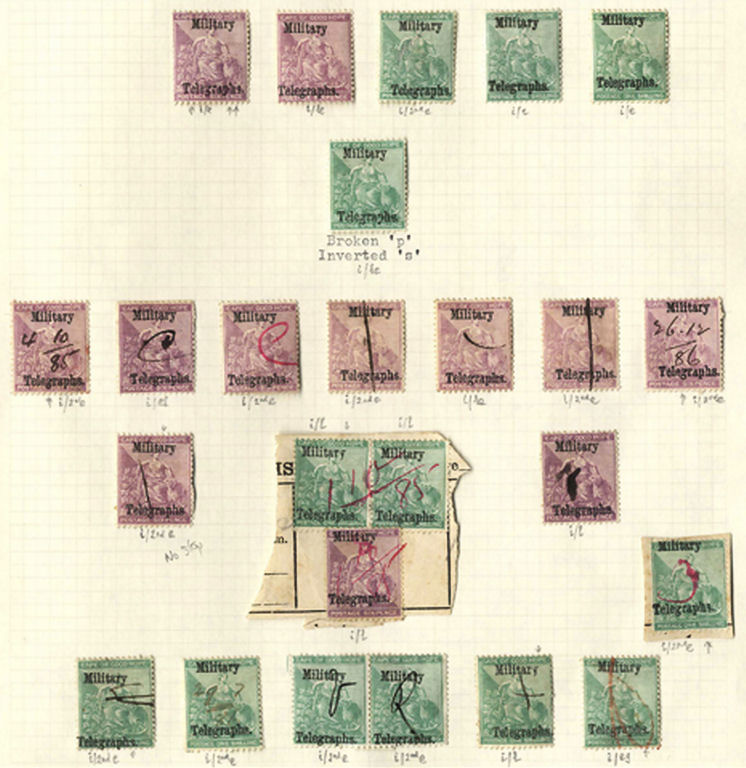
Courtesy of Spink and Son.
The Cape [of Good Hope] did more though than simply supply stamps for use in Bechuanaland.The British Military Telegraph stamps were also used there.
| Cape Colony Jan to April 1885 | shown | |
|---|---|---|
| GL | Barkly West | x |
Barkly West in Northern Cape was the jumping off point for Bechuanaland, though examples the Code GL is very scarce.
Anybody have one ?
| A pair of Bechuanaland Protectorate stamps used at Ootsi (Outsi). Cancelled O--S16.V.00. |
Hand drawn for clarity. |
 |
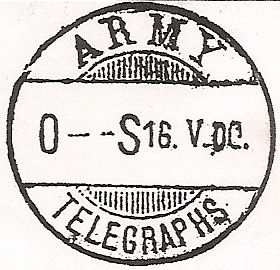 |
| Images courtesy of Brian Fenemore. | |
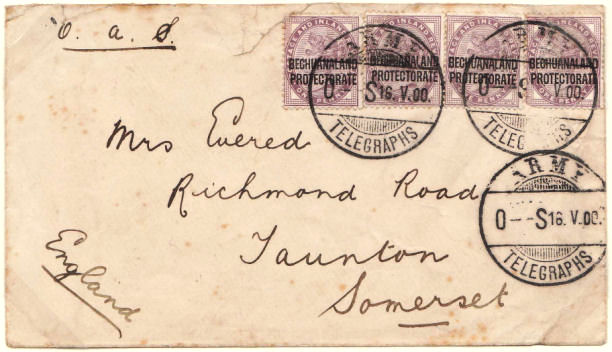 |
| This O.A.S. cover, using the same stamps and also on the same date of 16th. May comes courtesy of Nick Harris. Ootsi was the base for the Mafeking Armoured Train |
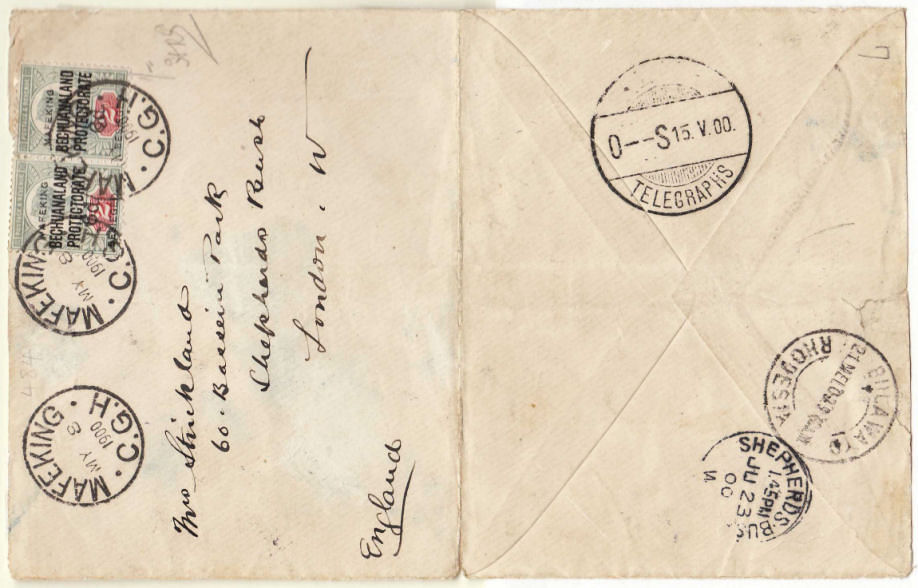 |
| This cover sent from Mafeking on 8th May 1900, has an Ooatsi Army Telegraph backstamp of 15th May Reinforcements began arriving at Mafeking on the 16th. May, ending the siege. Courtesy of Nick Harris. |
I would really like to hear from anyone with any other stamps from this series with Army Telegraph cancellations.
The covers above prompt me to add the halfpennies, 2d, 3d, 4d and 6d to the list below.
Even though I have not (yet) seen them, they may well exist.
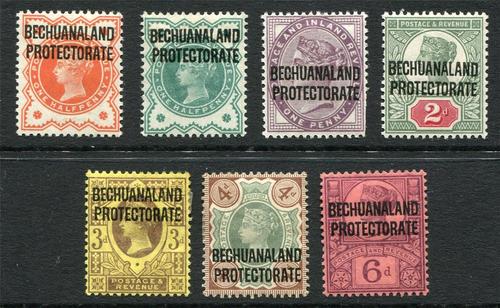
This is an earlier series, but there may also be forgeries of the later ones. Image courtesy of Bridger & Kay Ltd.
| UDes. | Hisc. | Description | Mint | Used |
|---|---|---|---|---|
| AT-Bec-33 | (GB) H9 | 6d bright purple (SG52) | 30.00 | 10.00 |
| AT-Bec-33a | (GB) H9a | top of 't' in 'Military' missing | 35.00 | 15.00 |
| AT-Bec-33b | (GB) H9b | 'Telegraphs' over 'Military' | 60.00 | 30.00 |
| AT-Bec-33c | Inverted 's' in 'Telegraphs' | 50.00 | 25.00 | |
| AT-Bec-33d | 'Military' doubled | 50.00 | 25.00 | |
| AT-Bec-34 | (GB) H10 | 1s green (SG26) | 35.00 | 12.00 |
| AT-Bec-34a | (GB) H10a | stop of 'Telegraphs' omitted | 45.00 | 15.00 |
| AT-Bec-34b | (GB) H10b | 'Telegraphs' omitted | 100.00 | 50.00 |
| AT-Bec-34c | (GB) H10c | Overprint misplaced to left | 40.00 | 13.00 |
| AT-Bec-34d | 'Telegraphs' over 'Military' | 70.00 | 35.00 | |
| AT-Bec-34e | 'Military' doubled | 60.00 | 30.00 | |
| AT-Bec-34f | Inverted 's' in 'Telegraphs' | 60.00 | 30.00 | |
| AT-Bec-35 | Army Pmk on ½d vermilion ovpt "Bechuanaland Protectorate" | 1.20 | 60.00 | |
| AT-Bec-36 | Army Pmk on ½d green | 1.50 | 60.00 | |
| AT-Bec-37 | Army Pmk on 1d lilac | 3.50 | 50.00 | |
| AT-Bec-38 | Army Pmk on 2d green and red | 2.50 | 60.00 | |
| AT-Bec-39 | Army Pmk on 3d purple on yellow | 4.50 | 70.00 | |
| AT-Bec-40 | Army Pmk on 4d green and brown | 12.00 | 80.00 | |
| AT-Bec-41 | Army Pmk on 6d purple on rose red | 18.50 | 90.00 |
Look here for an explanation of the table.
Another interesting item, a letter from Mafeking, CGH to London, sent 7/12/1900, arriving 29/12/1900.
It bears the Telegraph cancel for Mafeking on the back.
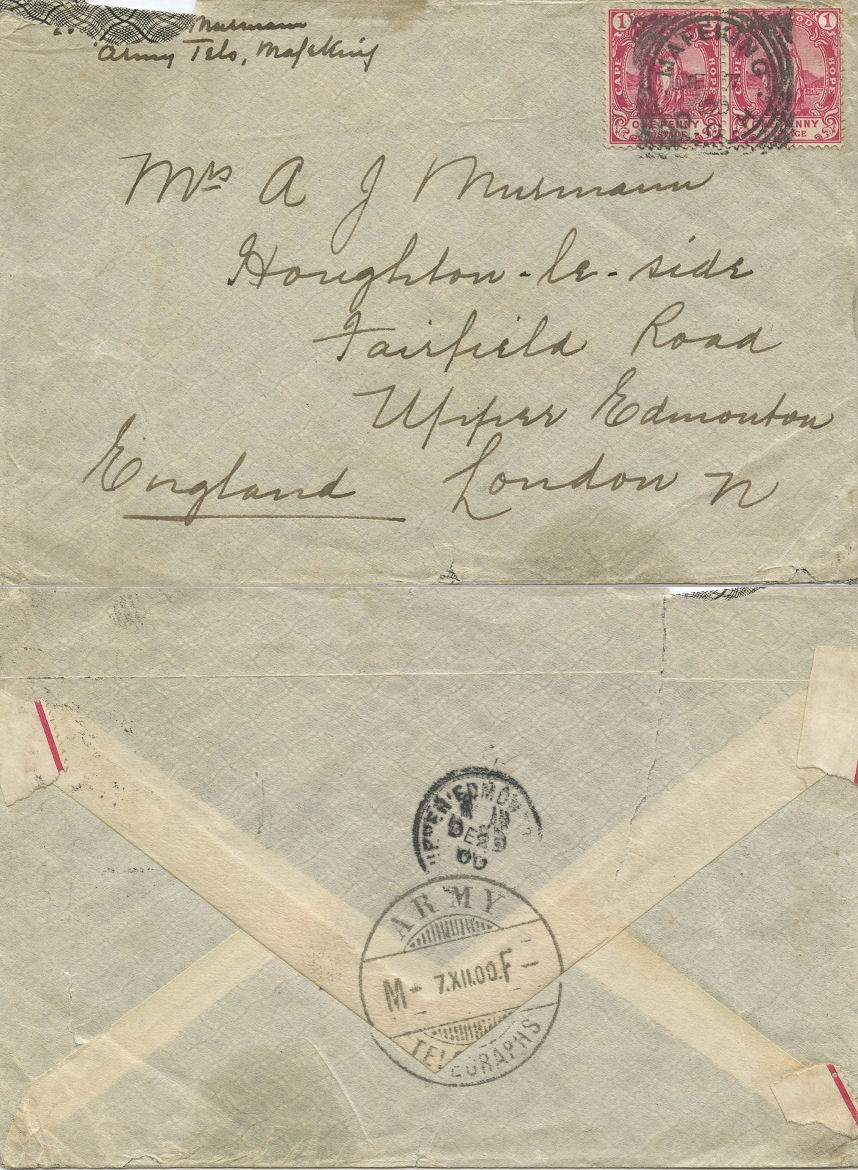
Image courtesy of the Transvaal Study Circle.
For an in-depth description of the Telegraph and Telephone operations see
History of the Telegraph Operations during the war in South Africa, 1899-1902 by Liet.-Colonel R. L. Hippisley, C.B., R.E. (21.5MB pdf download)
GB Army Telegraph stamps were used initially in Cape Colony, Natal and Transvaal, but ran out of them in the Transvaal and used what was available subsequently.
The book mentioned above gives a list of offices with opening and closing dates, it makes no mention of the telegraph codes used, or even the stamps.
Associating the codes with office names/locations is sometimes based on hard evidence, but has also been done by guesswork.
The evidence shows that either the list is incomplete, and/or some guesses are wrong.
Keep in mind that Hippisley left in 1902, before many of the offices closed, and probably before some opened.
I have made this page giving easier access to cleaned-up copies of most of his diagrams.
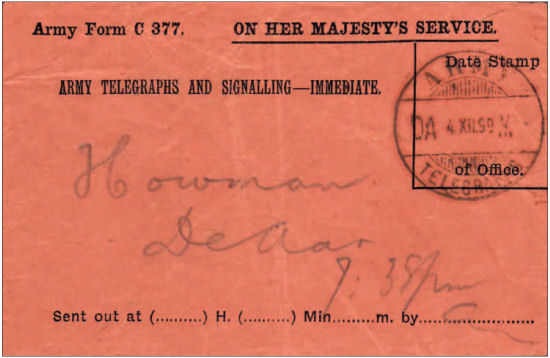
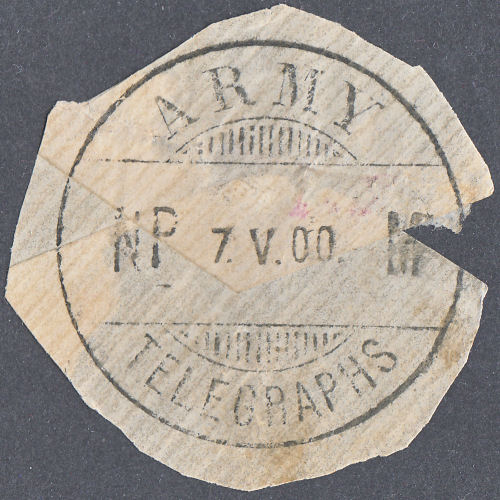
DA 4.XII.99 M- De Aar Military in the Cape (Source Andrew Higson) and 'NP 7.V.00 M-' thought to be Naauwpoort or Norvals Pont.

Enslin Military in the Cape, 22/1/1900, courtesy of Andrew Higson.
But they were not always cancelled in this way.
| Shortcuts to different sections | |||||
| Postage stamps | Narrow TF | Wide TF | 1903 | AT | Other |
When the British Army arrived in the Orange Free State, they had little or none of the British Army Telegraph stamps left.
There are a number of unidentified cancels known on them that may have been in the OFS, but I know of no definite examples.
A (28.7 MBytes) PDF file prepared and made available by Robert W. Hisey and R. Timothy Bartshe, does have a chapter that could be very helpful for this.
It contains maps and a list of offices. I have therefore created this V2Ch1 html version of the chapter for convenience.
British troops under Lord Roberts entered Bloemfontein on 13th March 1900 and declared the stamps and stationery of the Orange Free State invalid.
Local Bloemfontein printers Curling & Co., prepared the V.R.I. overprints within a few days, V.R.I. standing for 'Victoria Regina Imperatrix'.
On Monday March 19, the Post Office opened for business with supplies of ½d, 1d, 2½d and 1s stamps. On the 21st., the 4d, 6d carmine and 5s were issued.
On the 24th, the 6d carmine was exhausted and replaced by 6d blue. Friday, March 30th., the 2d was issued, and Monday, April 2nd., the 3d was issued.
The earliest known use of stamps overprinted with V.R.I. and used by the Army Telegraphs being this 21st March 1900, on a block of four ½d on ½d stamps,
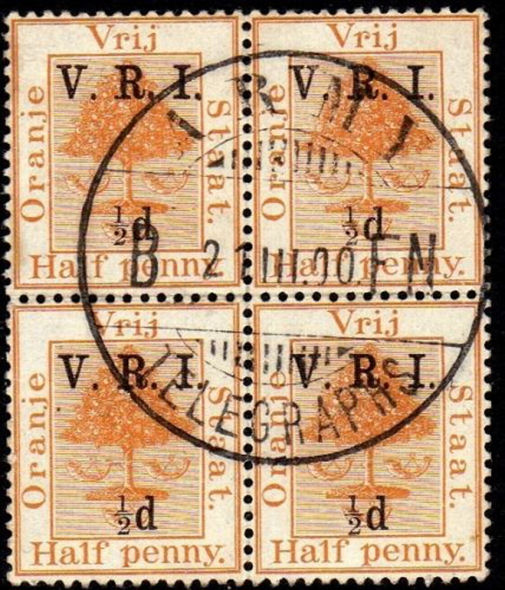
Image courtesy of Andrew Higson. Click image for listing.
but examples are known used outside Bloemfontein, by the Army Telegraphs without the overprints long after that.
The O.F.S. was formally annexed to the British Crown and renamed the Orange River Colony on 28 May 1900.
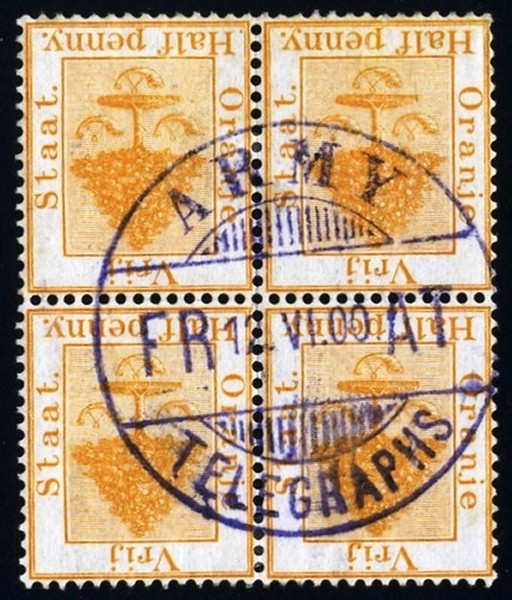 |
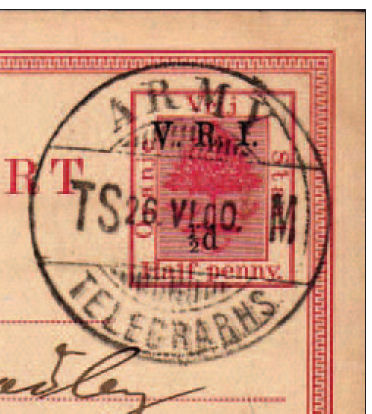 AT-OFS-P4 |
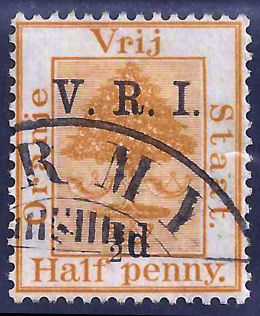 AT-OFS-P5 |
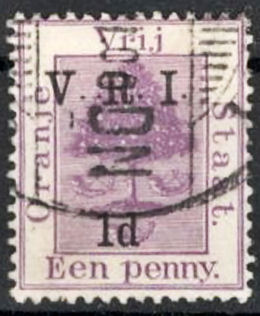 AT-OFS-P6 |
 AT-OFS-P13 |
| No overprints, a block of 4 halfpenny postage stamps, AT-OFS-P3. FR 12.VI.00 AT was not on my list, but Bram Leeflang who kindly supplied the scan tells me it is Frankfort, with the reference: Orange Free State Philately Vol.2 by Robert W.Hisey and R.Timothy Bartshe (2004) allocates this datestamp FR date AT to Frankfort. It is shown in their book on page 141. Perhaps Frankfort had not yet received a supply of overprinted stamps. I have subsequently seen a similar block in an email from Tim Bartshe. It has the same date and colour, but stamped the right-way up. He described it as the second earliest date reported and surely philatelic. |
Card sent from Bloemfontain. Contents say "Telegraph broken down...". Could 'TS M' stand for 'Telegraph Section Military'? (Source: Andrew Higson) |
An Army Telegraph cancel on the V. R. I. ½d on ½d stamps. Notice that in V. R. I. all the stops are at the bottom. This is the first issue. In later issues they were raised, though with some odd low ones. Image courtesy of Tim Walsh. This is the only one I have seen so far. |
The Army Telegraph cancel is also known used on the V. R. I. 1d on 1d stamps. Three examples are shown lower down of covers from Brandfort Military to Green Point Prisoner of war Camp in Capetown. These have cancels of B- 29.V.00 DN the day after annexation, B- 6.VI.00 DN and B- 23.VI.00 DN This stamp is likely to be from such a cover. Image courtesy of Ian Paterson. |
On the V. R. I. 1s on 1s stamp. Though only the last letter can be seen, this looks very similar to other examples of the _T H_ of Taaibosch, known from the day before. Image courtesy of Ian Paterson. |
| UDes. | Description | known | Used | On cover |
|---|---|---|---|---|
| AT-OFS-P1 | Army Telegraph Cancel on form or cover, no stamp. | Yes | - | - |
| AT-OFS-P2 | Army Telegraph Cancel on other piece, no stamp. | - | - | |
| AT-OFS-P3 | ½d orange postage stamp (no overprint, code FR AT) | Yes | - | - |
| AT-OFS-P4 | ½d on ½d red VRI postal stationery (code TS M) | Yes | - | - |
| AT-OFS-P5 | ½d on ½d VRI orange postage stamp (code B FN) | Yes | - | - |
| AT-OFS-P6 | 1d on 1d VRI purple postage stamp (code B DN) | Yes | - | - |
| AT-OFS-P7 | 2d on 2d VRI mauve postage stamp | - | - | |
| AT-OFS-P8 | 2½d on 3d VRI blue postage stamp | - | - | |
| AT-OFS-P9 | 3d on 3d VRI blue postage stamp | - | - | |
| AT-OFS-P10 | 4d on 4d VRI blue postage stamp | - | - | |
| AT-OFS-P11 | 6d on 6d VRI red postage stamp | - | - | |
| AT-OFS-P12 | 6d on 6d VRI blue postage stamp | - | - | |
| AT-OFS-P13 | 1s on 1s VRI brown postage stamp (code T? H) | Yes | - | - |
| AT-OFS-P14 | 5s on 5s VRI green postage stamp | - | - | |
| AT-OFS-P15 | ORC overprint on ½d green COGH stamp | - | - | |
| AT-OFS-P16 | ORC overprint on 1d red COGH stamp | - | - | |
| AT-OFS-P17 | ORC overprint on 2½d blue COGH stamp | - | - | |
| AT-OFS-P18 | Orange River Colony ½d green KEVII postage stamp (set of 1903-1904) | - | - | |
| AT-OFS-P19 | Orange River Colony 1d carmine KEVII postage stamp (code -N F-) | Yes | - | - |
| AT-OFS-P20 | Orange River Colony 2d chocolate KEVII postage stamp | - | - | |
| AT-OFS-P21 | Orange River Colony 2½d ultramarine KEVII postage stamp | - | - | |
| AT-OFS-P22 | Orange River Colony 3d violet KEVII postage stamp | - | - | |
| AT-OFS-P23 | Orange River Colony 4d olive & carmine KEVII postage stamp | - | - | |
| AT-OFS-P24 | Orange River Colony 6d violet & carmine KEVII postage stamp | - | - | |
| AT-OFS-P25 | Orange River Colony 1s bistre & carmine KEVII postage stamp (code S F-) | Yes | - | - |
| AT-OFS-P26 | Orange River Colony 5s brown & blue KEVII postage stamp | - | - |
I am sure there are many more to add. The P5-P14 was a series issued in 1900 with Anglicized overprints.
The KEVII Orange River Colony postage stamps (P19 and P25 are shown below) were issued in 1903, with the 5s in 1904.
1907 saw a change of watermark for the ½d, 1d, 4d and 1s.
Prior to the occupation, the Orange Free State used definitive stamps overprinted 'TF' for Telegraph purposes.
Though stamps were available overprinted V.R.I. / AT from July 1900, these can be seen dated much later than that.
Some of these were additionally overprinted 'V.R.I.' and used by the British Army for Telegraphs from 1900:
The various positions of the stops and other errors have been plated with the aid of blocks.
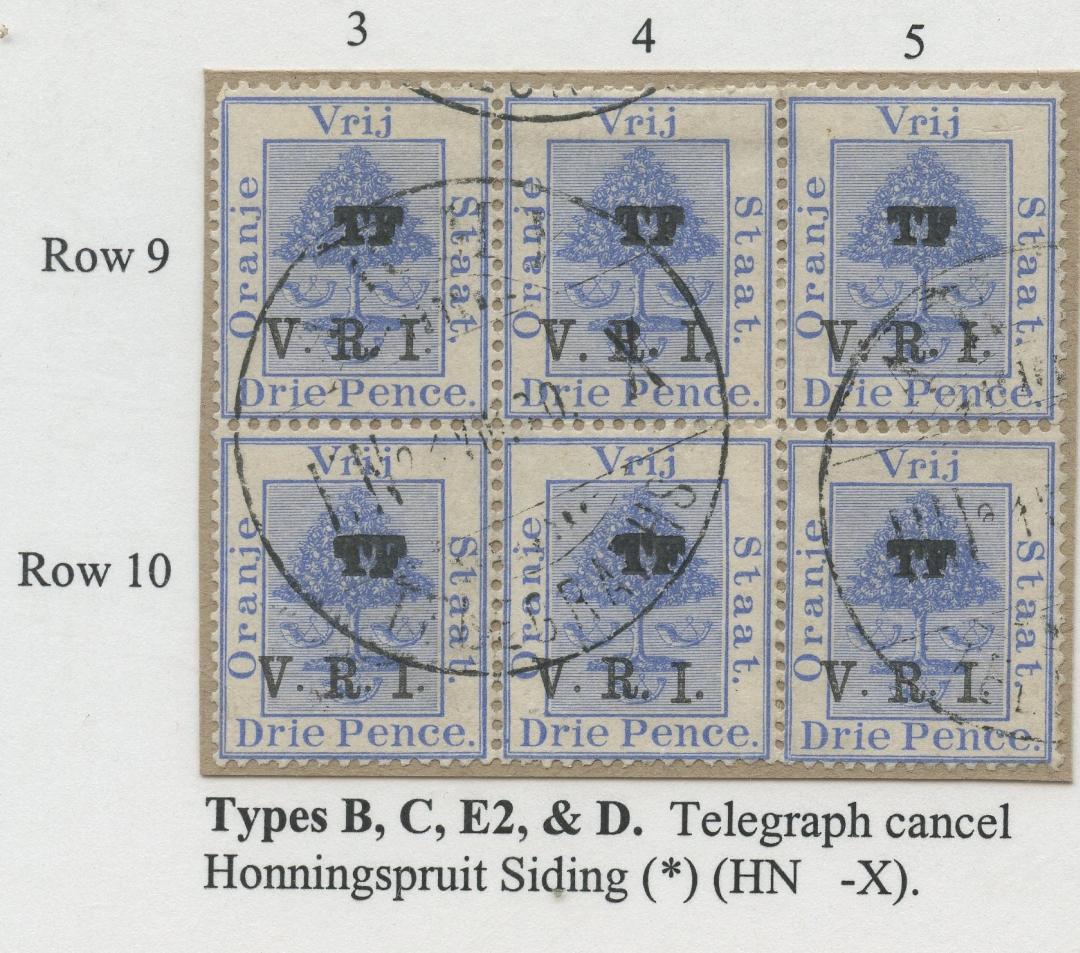
The code HN -X was at one time thought to be Heilbron, but research by Tim Bartshe lead to the conclusion that it was in fact Honningspruit Siding.
The image above and the one below are kindly provided by Tim Bartshe. These, together with a £1 example shown below, are all dated 21 August 1900, HN 21.VIII.00 X

It seems that some expensive telegrams were sent from Honningspruit Siding. Anyone have any other examples ?
Look here for an explanation of the table.
The overprints were in panes of 10 rows of 6. Numbers in brackets are positions within the pane of 60.
*AT-OFS-43n has been added due to the example shown above, courtesy of Bruce Warrender.
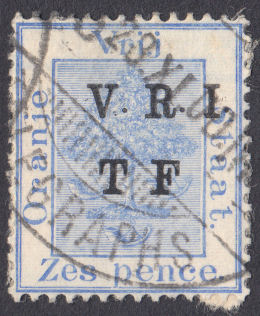 |
 |
 |
| 6d AT-OFS-44 (wide 'T F') | 1d on 1d(H40) OFS-H45 | 1d on 1d OFS-H46 |
Type OFS-H46 is similar to OFS-H45 but with a tall-thin 'TF' in blue-black ink.
Can anyone provide scans of H45 and/or H46, preferably with Army Telegraph cancels ?
| UDes. | Hisc. | Description | Mint | Used |
|---|---|---|---|---|
| AT-OFS-44 | H44 | 6d ultramarine | 150.00 | 100.00 |
| AT-OFS-44a | H44a | 'TF' displaced to right | 250.00 | 160.00 |
| AT-OFS-44b | H44b | 'V' stop low (6, 30, 53, 55) | - | - |
| AT-OFS-44c | H44c | 'V' and 'I' stops low; all stops larger (52) | - | - |
| AT-OFS-44d | H44d | 'R' and 'I' stops low; 'I' dropped (58) | - | - |
| AT-OFS-44e | H44e | no left serif on 'V' (4, 57) | - | - |
| AT-OFS-44f | H44f | 'R' stop low (46) | - | - |
| AT-OFS-44g | H44g | 'R' and 'I' stops low (40) | - | - |
| AT-OFS-44h | H44h | 'I' stop low (11, 36) | - | - |
| AT-OFS-44i | H44i | nick in curve of 'R' (16) | - | - |
| AT-OFS-44j | H44j | 'I' almost omitted | - | - |
| AT-OFS-45 | H45 | 1d on 1d (type H40) deep mauve | 300.00 | 250.00 |
| AT-OFS-46 | H46 | 1d on 1d (tall-thin 'TF') deep mauve | 300.00 | 250.00 |
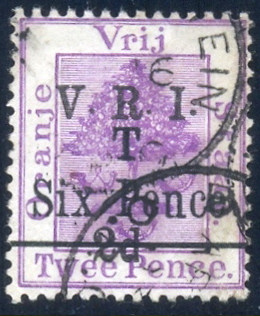 |
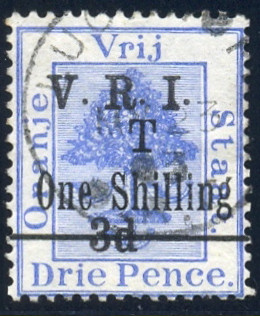 |
 |
| 6d on 2d OFS-H47 (OFS Pmk) | 1s on 3d OFS-H48 (OFS Pmk) | 1s on 3d H48c (position 21) |
| Images courtesy of Bram Leeflang. | Image courtesy of Bruce Warrender | |
The additional image provided by Bruce Warrender shows how the overprints are combined,
The 'V. R. I.' plus '3d' was originally for postage stamps, followed by 'T'
and also 'One Shilling' and bar
It seems strange that they did not simply apply a 'TF' to the 6d on 6d and 1s on 1s values ?
The 'T' aligns differently to the 'Shilling' on these two. Also the 'g' is very different.
Can anyone provide scans of these with Army Telegraph cancels ?
| UDes. | Hisc. | Description | Mint | Used |
|---|---|---|---|---|
| AT-OFS-47 | H47 | 6d on 2d on 2d bright mauve | 125.00 | 125.00 |
| AT-OFS-47a | H47a | thick 'V' (12, 30, 37, 43, 53, 58) | 175.00 | 175.00 |
| AT-OFS-47b | H47b | inverted '1' for 'I' (37) | 200.00 | 200.00 |
| AT-OFS-47c | H47c | break in bar under 'P' | 150.00 | 150.00 |
| AT-OFS-47d | H47d | break in bar under gap | 150.00 | 150.00 |
| AT-OFS-47e | H47e | large stop after 'I' (9, 21, 52, 60) | 150.00 | 150.00 |
| AT-OFS-48 | H48 | 1s on 3d on 3d ultramarine | 100.00 | 100.00 |
| AT-OFS-48a | H48a | thick 'V' (12, 30, 37, 43, 53, 58) | 125.00 | 125.00 |
| AT-OFS-48b | H48b | inverted '1' for 'I' (37) | 150.00 | 150.00 |
| AT-OFS-48c | H48c | large stop after 'I' (9, 21, 52, 60) | 125.00 | 125.00 |
| AT-OFS-48d | H48d | break in bar under 1st 'i' | 125.00 | 125.00 |
| AT-OFS-48e | H48e | break in bar under 'h' | 125.00 | 125.00 |
| AT-OFS-48f | H48f | break in bar under 'S' | 125.00 | 125.00 |
| AT-OFS-48g | H48g | 'V.R.I.' overprint double | 250.00 | 250.00 |
Types 44-48 are all relatively scarce, even without an 'Army Telegraph' cancellation.
By July 1900 the definitive stamps were being overprinted 'V.R.I./AT' and used by the British Army:
Hiscocks lists 1d, 3d, 6d, 1s and 5s as types 49-53.
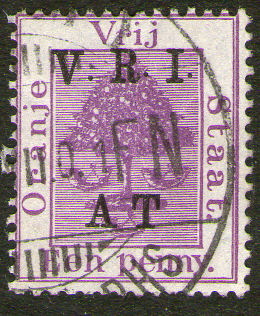 |
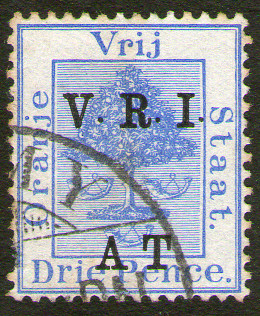 |
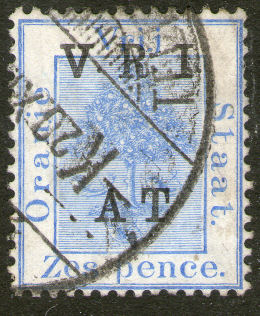 |
 |
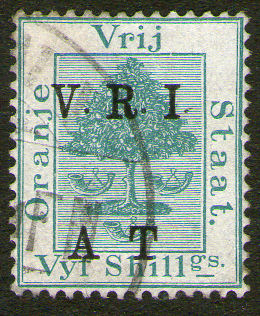 |
| 1d OFS-H49 | 3d OFS-H50 | 6d OFS-H51a (thick 'V') | 1s OFS-H52a (thick 'V') | 5s OFS-H53 |
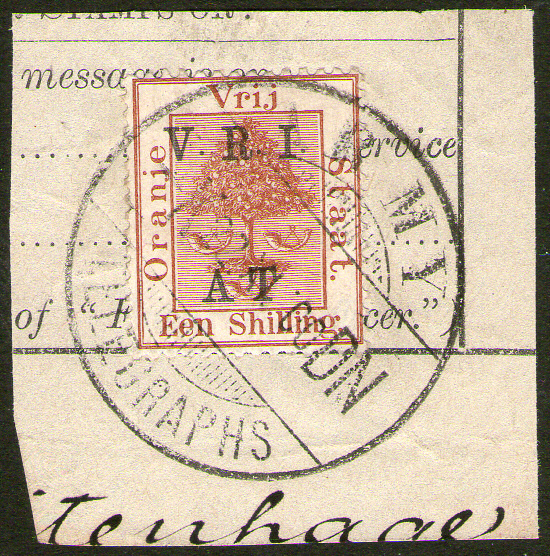 -K 22.XI.00 DN (Kroonstad) on a piece of Telegraph Form. (interestingly with the same date as the Transvaal Xmas card one below) |
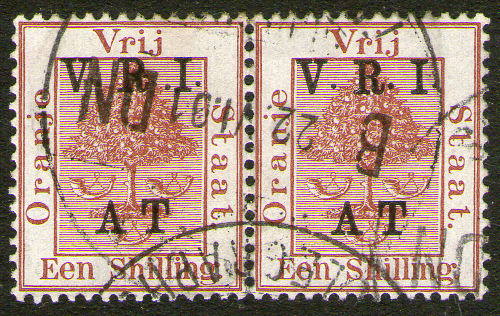 B 22.VI.01.DN Brandfort Military on H52 pair. |
These have the same overprint as the 5s (H53, 'AT' 7mm long) above and hence share the same error varieties.
The large size of these is helpful in seeing the whole telegraph code.
According to Steve Hiscocks, the V. R. I. / AT overprint came out in 1901, but there is evidence that it was in 1900.
According to Langmead & Huggins, on 1 January 1902 the civil and military telegraphs in South Africa were amalgamated
to form the South African Telegraph Union.
OFS/ORC became part of the Union of South Africa in June 1910, but a couple below are dated August 1910. Date errors ?
| UDes. | Hisc. | Description | Mint | Used |
|---|---|---|---|---|
| AT-OFS-54 | H54 | 10s orange | 60.00 | 40.00 |
| AT-OFS-54a | H54a | thick 'V' (2, 14, 20, 40, 43, 46) | 80.00 | 60.00 |
| AT-OFS-54b | H54b | low and larger stop after 'V' (60) | 100.00 | 80.00 |
| AT-OFS-54c | H54c | no stop after 'V' (31) | 100.00 | 80.00 |
| AT-OFS-54d | H54d | broad short 'A' (35) | 100.00 | 80.00 |
| AT-OFS-54e | H54e | large stop after 'I' (24, 41) | 100.00 | 80.00 |
| AT-OFS-55 | H55 | £1 claret | 80.00 | 60.00 |
| AT-OFS-55a | H55a | thick 'V' (2, 14, 20, 40, 43, 46) | 200.00 | 80.00 |
| AT-OFS-55b | H55b | low and larger stop after 'V' (60) | 120.00 | 100.00 |
| AT-OFS-55c | H55c | no stop after 'V' (31) | 120.00 | 100.00 |
| AT-OFS-55d | H55d | broad short 'A' (35) | 120.00 | 100.00 |
| AT-OFS-55e | H55e | large stop after 'I' (24, 41) | 120.00 | 100.00 |
| AT-OFS-56 | H56 | £4 rose | 120.00 | 100.00 |
| AT-OFS-56a | H56a | thick 'V' (2, 14, 20, 40, 43, 46) | 14.00 | 120.00 |
| AT-OFS-56b | H56b | low and larger stop after 'V' (60) | 160.00 | 140.00 |
| AT-OFS-56c | H56c | no stop after 'V' (31) | 160.00 | 140.00 |
| AT-OFS-56d | H56d | broad short 'A' (35) | 160.00 | 140.00 |
| AT-OFS-56e | H56e | large stop after 'I' (24, 41) | 160.00 | 140.00 |
Nearly all of the used examples of these have Army Telegraph cancels.
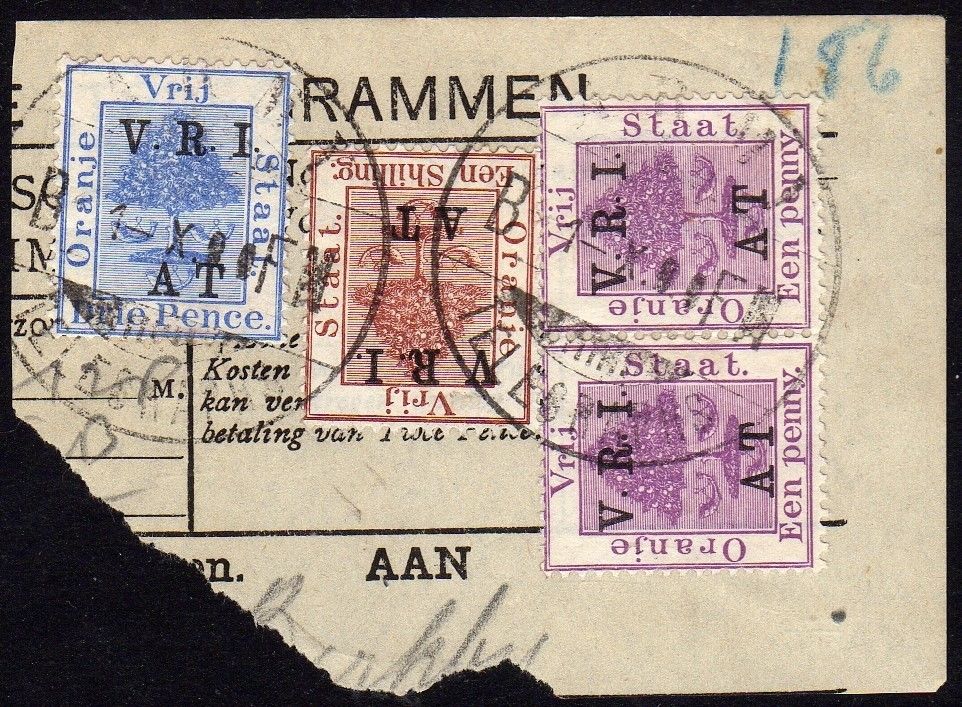
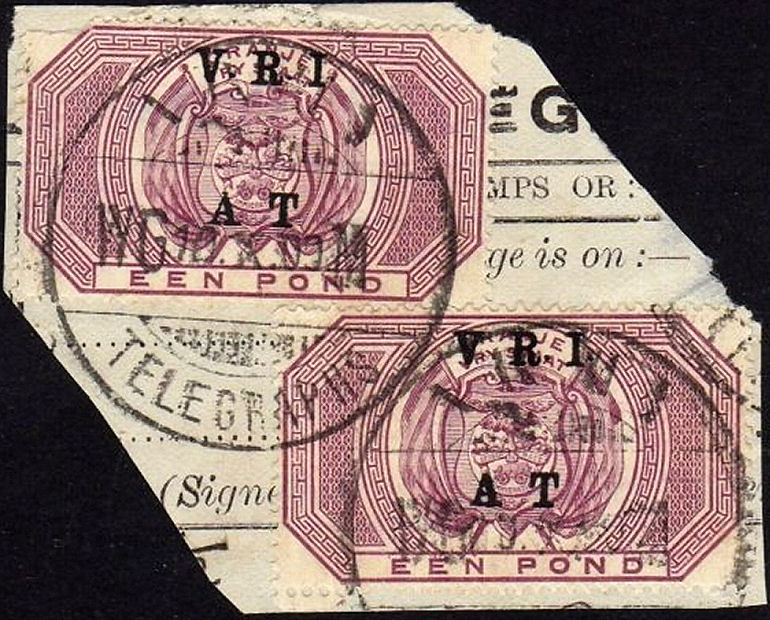
The top Bloomfontein one is using OFS forms, whereas the (scarce) Winburg Military one below is on a British Army form.
Images courtesy of Andrew Higson. Click images for listing.
Telegram from Pretoria (Transvaal) to Bloemfontain dated 19/12/1900
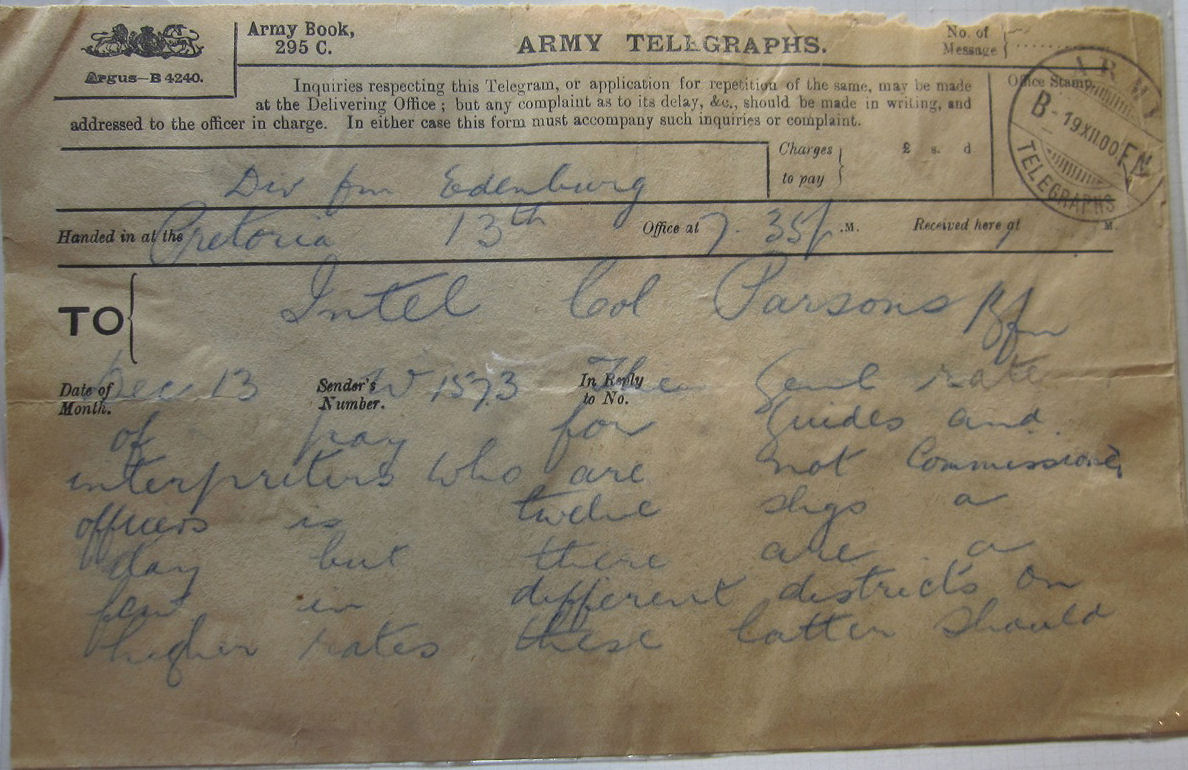
This was handed in on 13th December but did not reach Bloemfontain until the 19th, suggesting that the line had been cut.
It also appears to be unfinished. Image courtesy of Mark Gibson.
This card uses an ORC overprint on a Cape of Good Hope stamp to make up the 1d rate for a Xmas card to England.
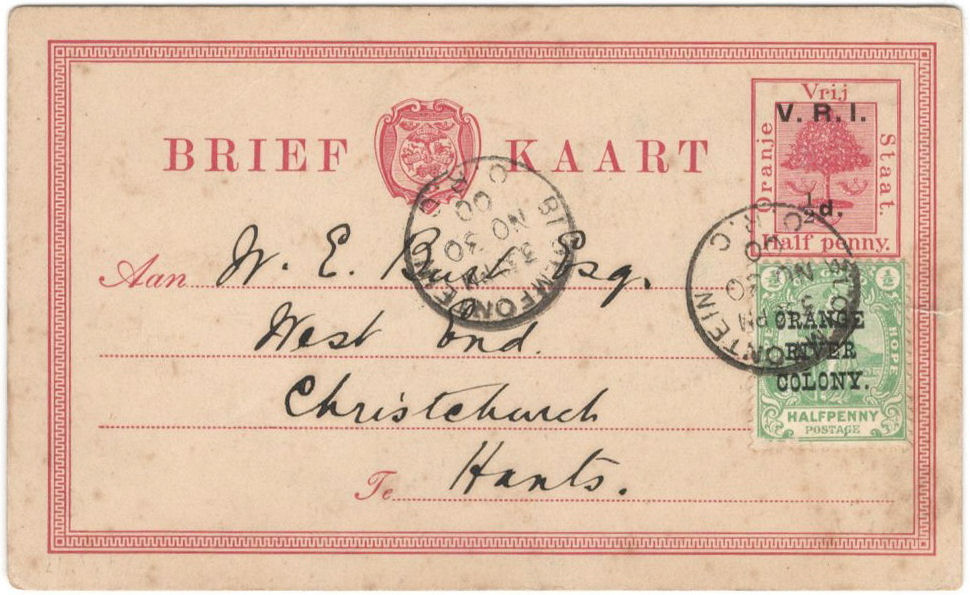
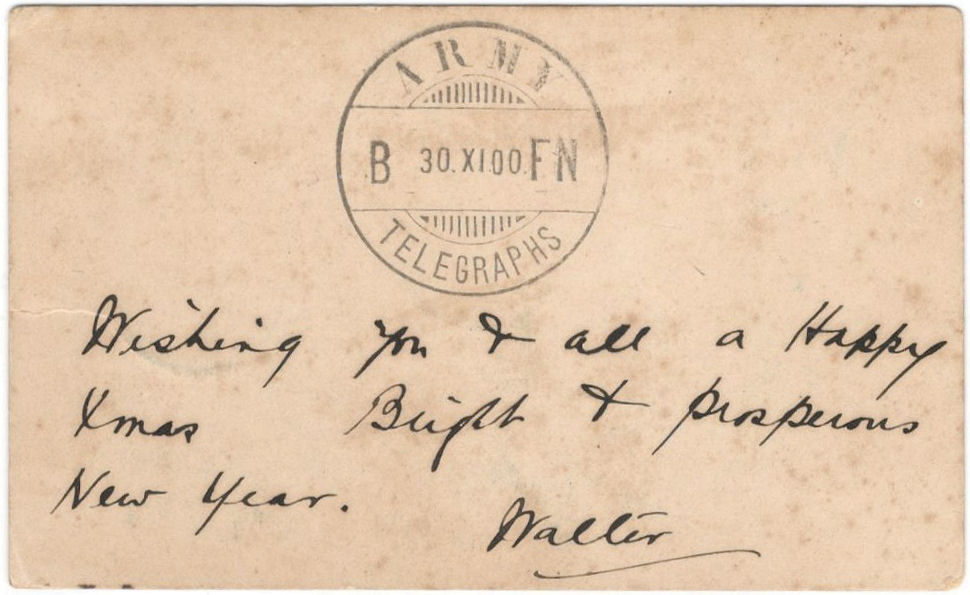
he back has a Bloemfontein Army cancel. Similar cards are known with Army cancels on the stamps.
Images courtesy of Ian Paterson.
I am told that In Nalder's book on the Royal Corps of Signals, he confirms that the Telegraph Battalion was abolished in 1905 and its constituent parts reformed with a subsequent restructure in 1907.
My table shows a lot of entries for Sudan in that time period, one entry for Transvaal (Machadodorp 16/3/1905), but nothing for ORC until a reference for FP 21.VII.07 KO and the following two:
Orange River Colony letter, -N 31.VIII.07 F- on 1d embossed.
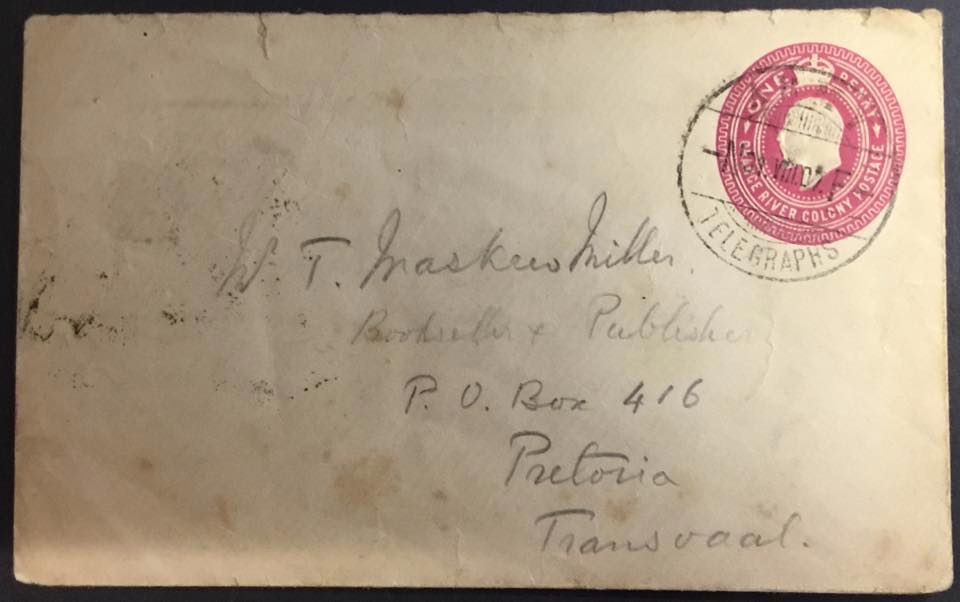
Image courtesy of Michael Wigmore. Associated with this item was a handwritten note in pencil :
“Northfield Farm - nr Bloemfontein - De Brug 9 miles - where Durban Light Infantry was sent in 1907 before the ORC elections.”
This is the earliest date I have seen for this.
Orange River Colony letter, -N 8.IX.07 F- on 1d postage stamp on envelope - courtesy of Mark Gibson.


The back shows it was sent from the Sutherland Highlanders.
Below is another with the same date.
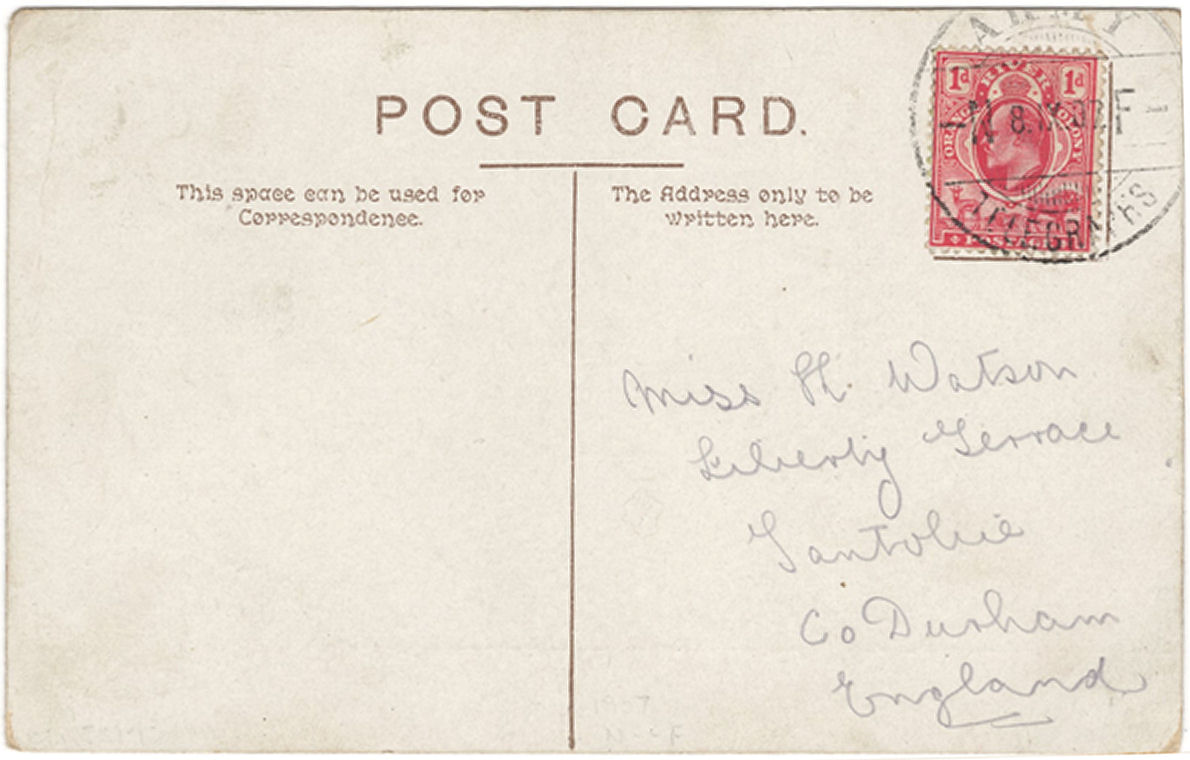
Image courtesy of Ian Paterson.
The other 1907 code I have seen is S 10.IX.07. F-
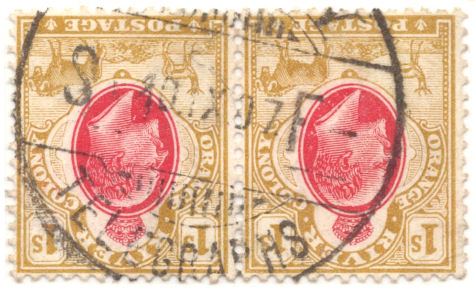
This is thought to have been Springfontein, despite that previously being -S FN
Perhaps this is now a civilian code for it. Image courtesy of Ian Paterson.
Brandfort Military
Prisoners letter, B- 29.V.00 DN (the day after annexation) on 1d V.R.I. postage stamp - courtesy of Grosvenor Auctions.
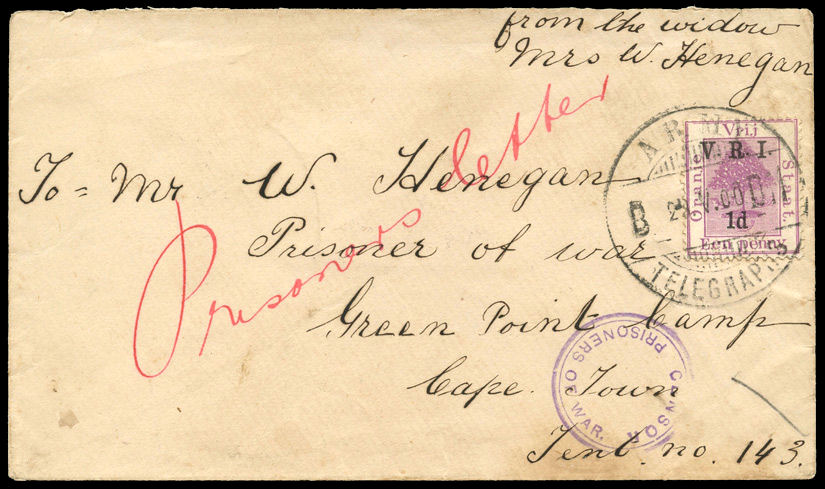
Prisoners letter, B- 6.VI.00 DN on 1d V.R.I. postage stamp - courtesy of John Church.
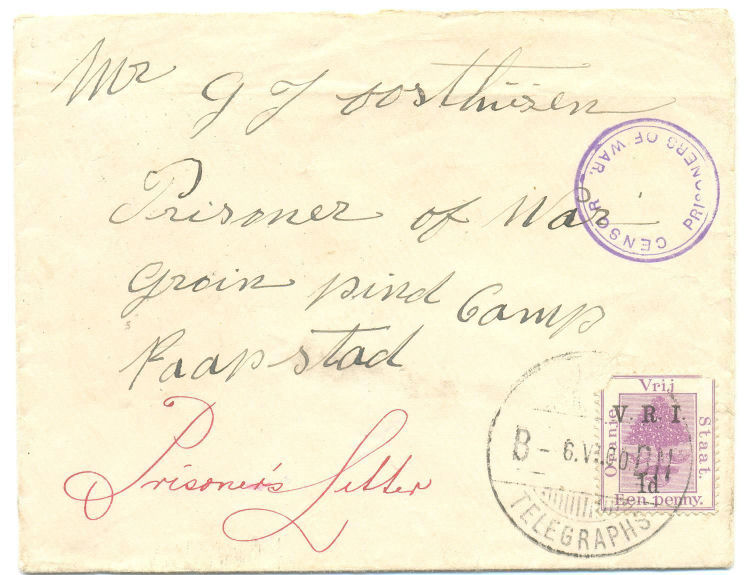
Prisoners letter, B- 23.VI.00 DN on 1d V.R.I. postage stamp - courtesy of Grosvenor Auctions.
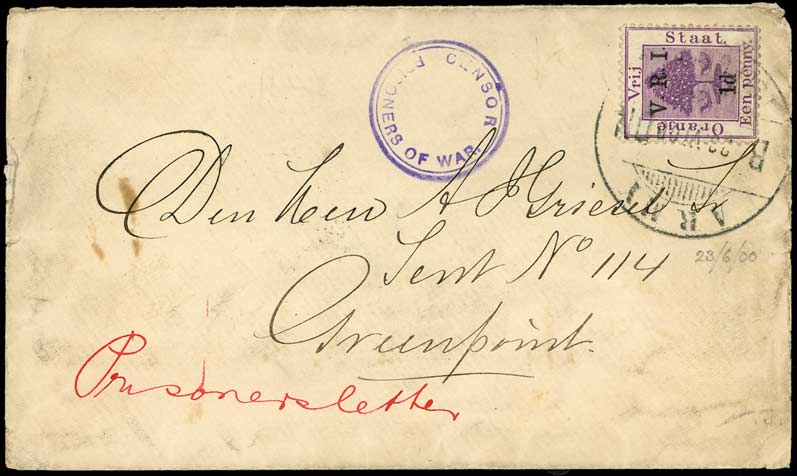
Taaibosch Camp
Letter - inside - dated 22/11/1900, ( T22.XI.00.H on ½d on ½d V.R.I. and 4d on 1d postage stamps
This is intended as an Xmas card, and for the end of the year 1900 and beginning of a New Century.
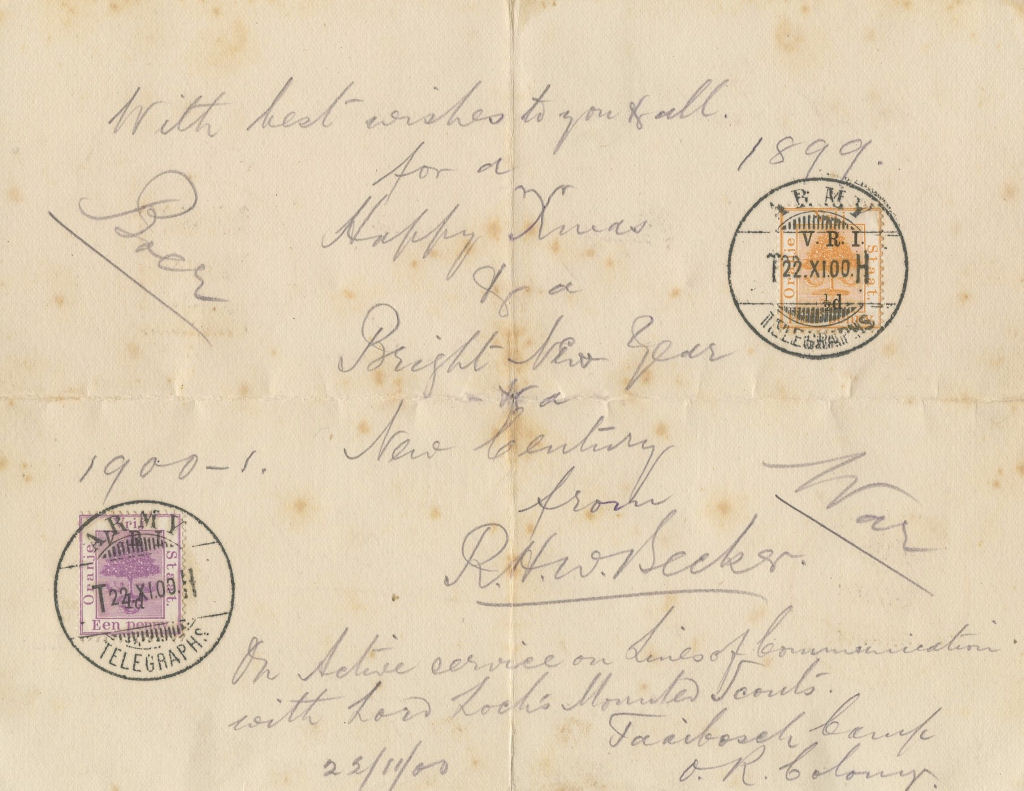
From R. H. Becker. On Active Service on Lines of Communication with Lord Loch's Mounted Scouts.
Taaibosch Camp, O. R. Colony. 22/11/00. It was folded in four, with the outside being :

The penny stamp is cancelled "Field Forces / British Army / No 24 / 00" - presumably these were applied somewhere in Africa.
The London E. C. backstamp is dated 14 December 1900.
Images courtesy of the OFS Face Book Group.
There is an interesting reference (dated 16/4/1901) to an exchange of telegrams about four months after the letter above :
"[2?]nd, DA to GOC, Kroonstad: 'I have been in communication with G.O.C. Vereeningen [sic] who says that owing to re-arrangement of garrison he cannot give protect to a Refugee Camp at Taaibosch.
Can you possibly arrange that white & black refugees being brought into Wolwehoek can be permitted to retain for a day or so as shelters the wagons in which they are brought in.
It will be necessary I am afraid to bring these people to Kroonstad but before doing so I will try & get tents for them unless there are any in your Ordnance Stores which I can obtain.
Would you consent to a Refugee Camp being started at or near Koppies Station it appeared to me a suitable place if water obtainable." To which the response was :
"Wolwehoek highly unsuitable for refugee camp please arrange to send them to Vredefort Rd. Have no tents in Ordnance here & I fear the wagons
will be required immediately by Gen Elliot for transportation. Kopjes is also unsuitable. When you can arrange for tents better rail them to Kroonstad."
The letter above refers to Lord Loch's Mounted Scouts. "Loch's Horse" was disbanded in England in April 1901. Clearly the exchange of 16 April 1901 had severe consequences for the camp.
I had assumed that all the Prisoners of War were kept in Africa, but it appears that is a long way from the truth. As many as 9,000 were sent to India alone. Apparently Deadwood Camp and Broadbottom Camp at St Helena were the first but
qickly filled up. Then Diyatalawa Camp in Ceylon was used. After that India was used, followed by
5 islands of Bermuda. 900 who had crossed into Mozambique were sent to Alcobaca Camp in Portugal.
Hippisley listed Taaibosch Spruit from 26 May 1900 to 28 May 1900, and Taaibosch (Sutherland) from 6 December 1901 to 12 December 1901.
He apparently knew nothing of the Taaibosch involved with any of the communications above, perhaps because "Loch's Horse" were South African Irregulars.
Clearly the Army Telegraph cancel was used on postal items.
In some cases it was because the telegraph was out of action and mail was used as an alternative.
I will list the items with apparently postal use of the cancel, providing designations for items that probably existed.
Note: I have been given some scans of a list of the code letters used in the Boer War which I am told came from The Anglo-Boer War Philatelist of 1988.
It is a great pity that Langmead & Huggins did not include a more complete listing.
Hiscocks does not distinguish between stamps used with British Telegraphic markings and those used with Boer telegraphic markings,
but it is likely that both sides used captured stocks of the other side, sometimes from sheer necessity, but perhaps other times as an expedience.
There is more information and illustrations at: ORANGE FREE STATE STUDY CIRCLE
Varieties are documented in Stamps from the Orange Free State by Buckley & Marriott available from the study circle.
| Shortcuts to different sections | |||||
| Zegelregt | 1901 | C.O.G.H. | Provisionals | Forgeries | Other |
From the evidence, by the time the British Army entered the Transvaal, they were low on stocks of all but the high values.
When stocks ran out they used local stamps overprinted V. R. I. Later these stamps were overprinted "Telegraphs" and those items were listed by Hiscocks.
Provisionally however the Army Telegraphs used this series for low values without the "Telegraphs" overprint.
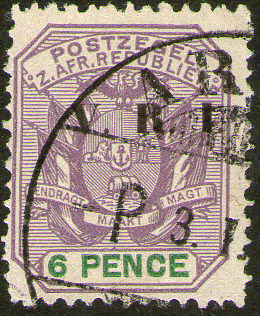
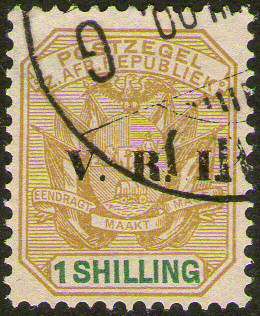
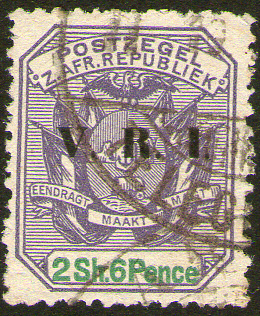

A better trio plus the scarce 10/- courtesy of Bram Leeflang.
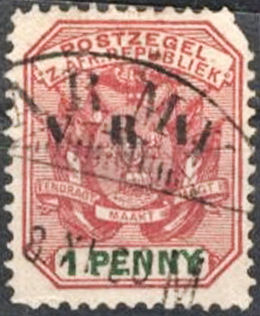
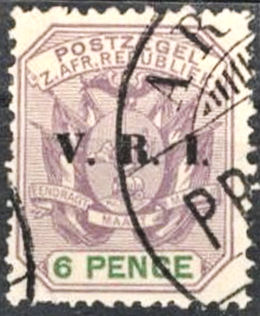
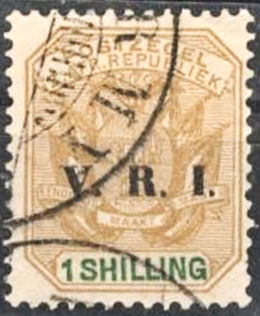
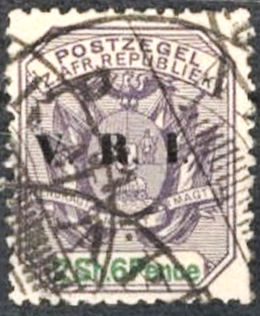
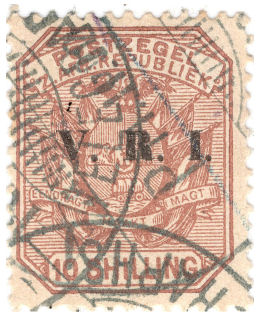
Another series courtesy of Ian Paterson that includes the very rare penny stamp and another 10/- (previously recorded by Alan Drysdall in 2004 with a different 10/-)
Interestingly, these two 10/- and the Drysdall example look like they were all used in Potchefstroom (-P . . C-) in 1902.
Perhaps strangely, I have yet to see the 5/- VRI value used this way. Anyone have a 5/- ?
Although Hiscocks did not list them, they are documented in 'The Transvaal Philatelist' journal of the “Transvaal Study Circle” TP 150 (May 2004) page 41.
These are normal postage stamps known used for telegraphic purposes from July 1900 to April 1901.
| UDes. | Description | known | Mint | AT Used |
|---|---|---|---|---|
| AT-Tran-1 | ½d green (SG226), perf. 12½ | Yes | 0.20 | 150.00 |
| AT-Tran-2 | 1d carmine-red and green (SG227), perf. 12½ | Yes | 0.20 | 120.00 |
| AT-Tran-3 | 2d brown and green (SG228), perf. 12½ | 1.50 | - | |
| AT-Tran-4 | 2½d blue and green (SG229), perf. 12½ | Yes | 0.40 | 150.00 |
| AT-Tran-5 | 3d purple and green (SG230), perf. 12½ | Yes | 0.40 | 150.00 |
| AT-Tran-6 | 4d sage green and green (SG231), perf. 12½ | 1.30 | - | |
| AT-Tran-7 | 6d dull purple and green (SG232), perf. 12½ | Yes | 1.40 | 100.00 |
| AT-Tran-8 | 1s ochre and green (SG233), perf. 12½ | Yes | 1.40 | 80.00 |
| AT-Tran-9 | 2s6d grey-lilac and green (SG234), perf. 12½ | Yes | 1.60 | 50.00 |
| AT-Tran-10 | 5s grey (SG235), perf. 12½ | 3.30 | 200.00 | |
| AT-Tran-11 | 10s brown (SG236), perf. 12½ | Yes | 4.50 | 200.00 |
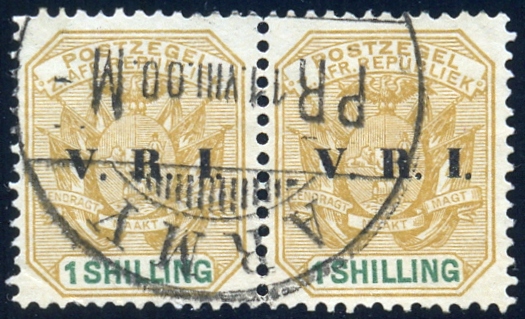
This is a pair with a clear Pretoria Military cancel, dated 2 weeks before the date the office was thought to have opened (25/8/1900).
As an indication of the scarcity of these stamps, the 'accumulation' of the actor Kenneth Griffith, a friend of Peter O' Tool
and avid collector of Boer War items, had 143 x 1s stamps, 16 x 2s6d stamps and single 1d, 2½d and 6d stamps.
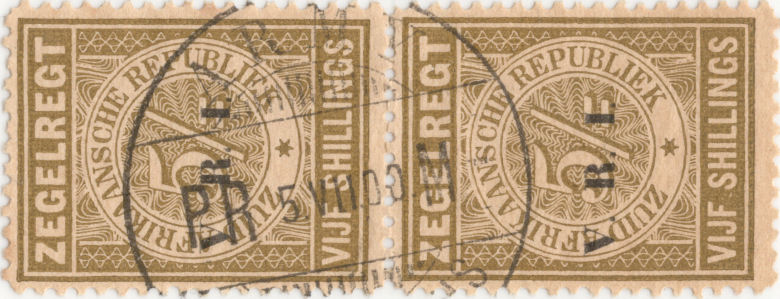
Here is an even earlier one, 5 June 1900 courtesy of Ian Paterson.
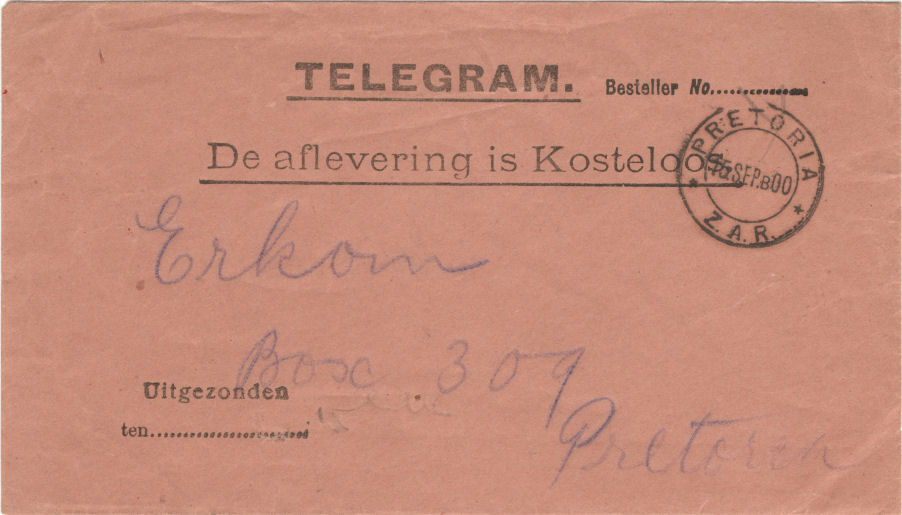
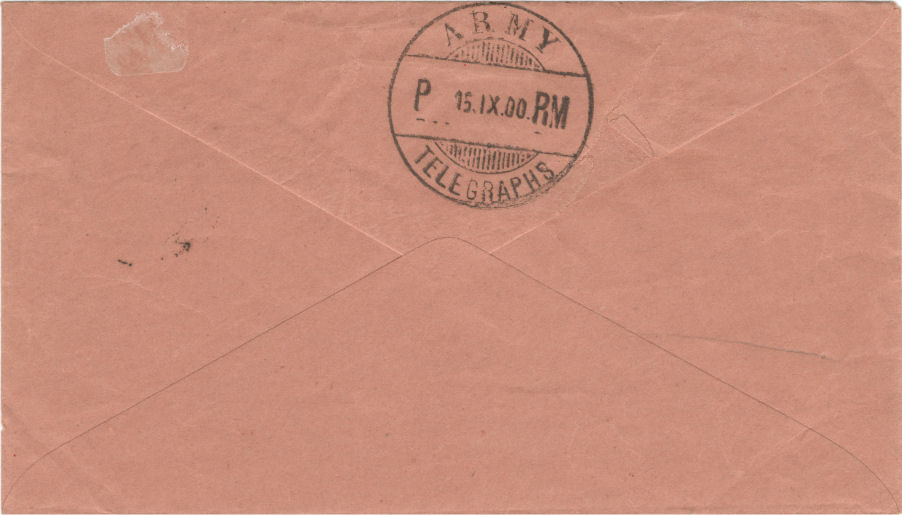
Front and back of a Boer delivery envelope used at Pretoria on 15 September 1900. Enkom means Arrived. This is stamped P 15.IX.00.RM note the marks under the letters. This different code appears to be associated with "Box 309"
"De aflevering is Kosteloos" means "Delivery is free of charge". Images courtesy of Ian Paterson.

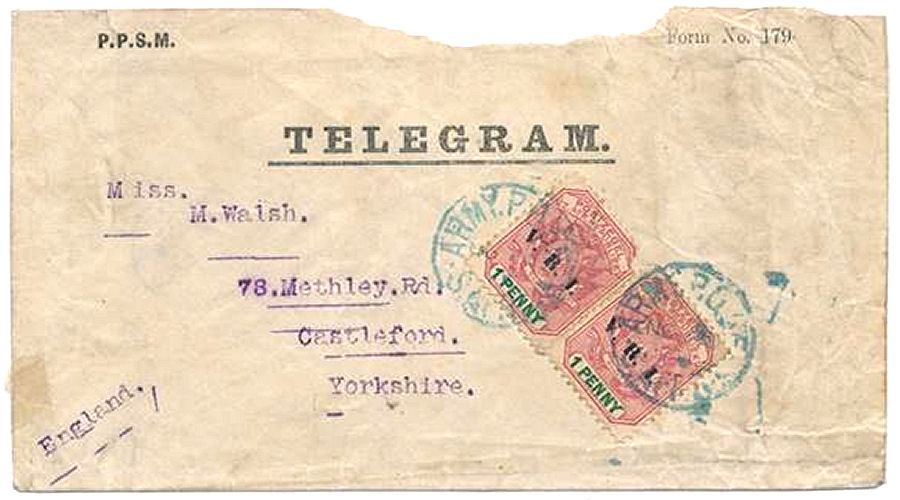
A similar envelope used in Johanneburg and a P.P.S.M. Form No. 179 sent Army Post to Castleford, Yorks. England. Images courtesy of the Transvaal Study Circle.
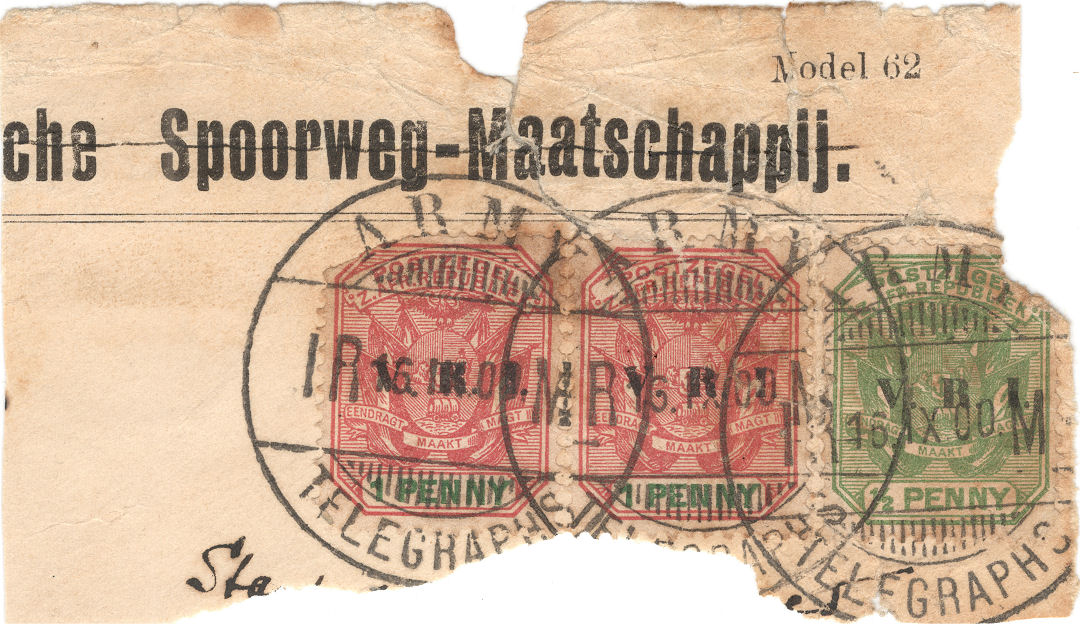
A piece from a form of the N.Z.A.S.M. This was the 'Nederlandsche Zuid-Afrikaansche Spoorwegmaatschappij' (Dutch South African Railway Company.
Used 16 September 1900 at Irene Military with the only non-philatelic use of the halfpenny that I've seen, courtesy of Ian Paterson.
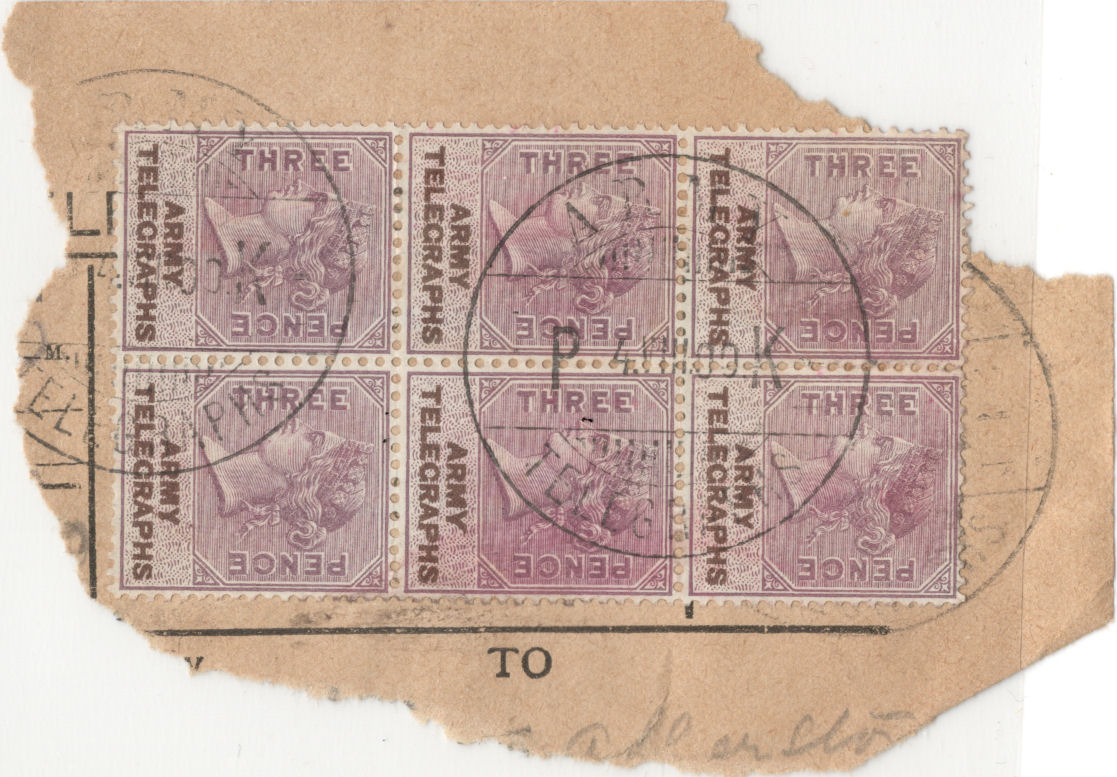
-P 4-VIII.00 K- latest known date of Paardekop, courtesy of courtesy of Ian Paterson.
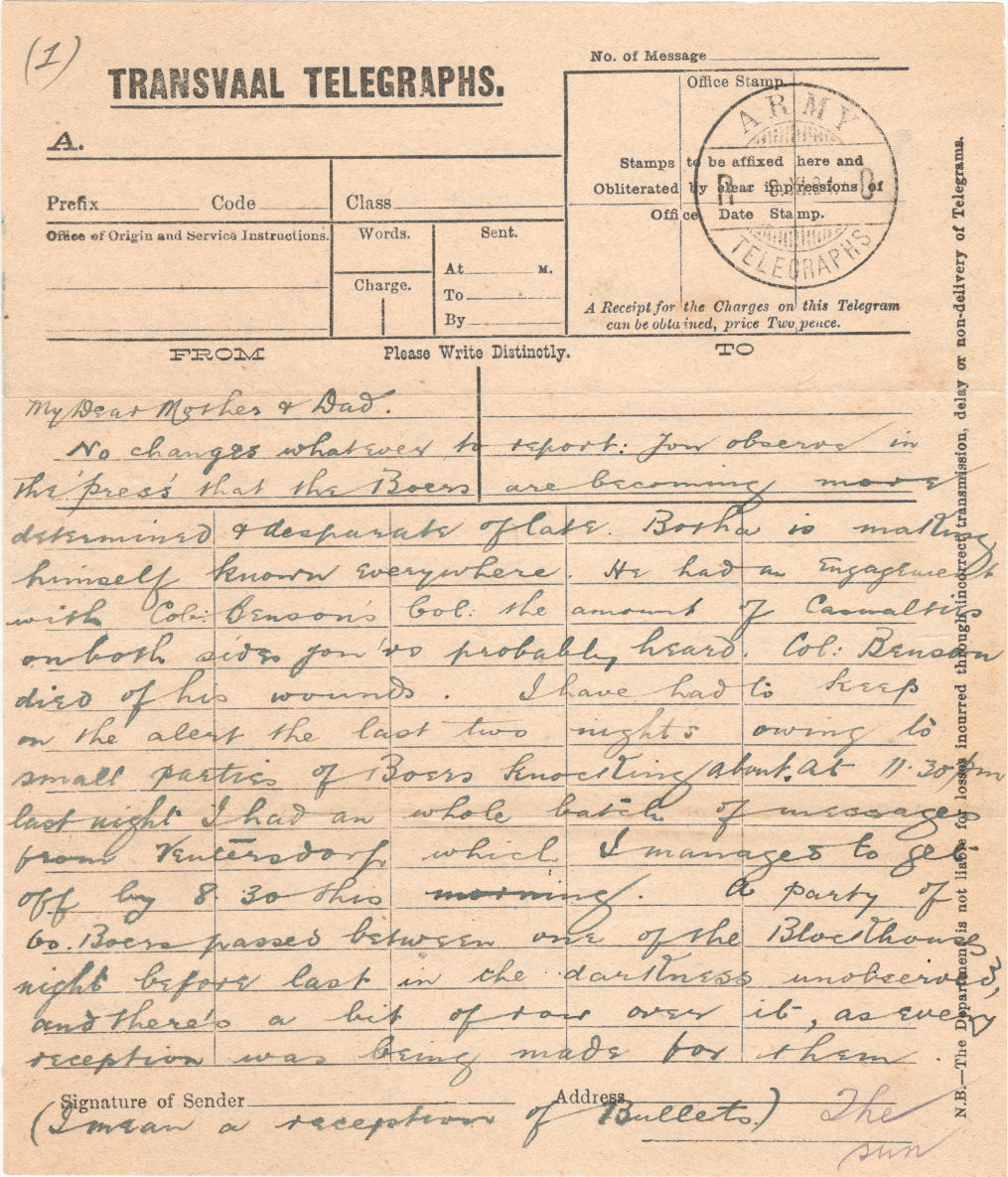
A convenient Transvaal Telegraphs form, used to write a letter home. It also bears a cancel of R- 8.XI.01.-O for Rooidraai.
After stocks of the GB Army Telegraph stamps ran out, Revenue stamps were also overprinted V.R.I and used by the British Army for telegraph purposes.
These are known used from July 1900 till about June 1902 (some later than others) with various perforations.
Anyone interested in Revenue stamps may find The Revenue Society of interest.
Hiscocks lists 1d, 6d, 1s, 1s6d, 2s, 2s6d, 5s, 10s, £1, £2 and £5 as types H1 to H11.
They are normally perf. 11½ but can be 11½ x 14.
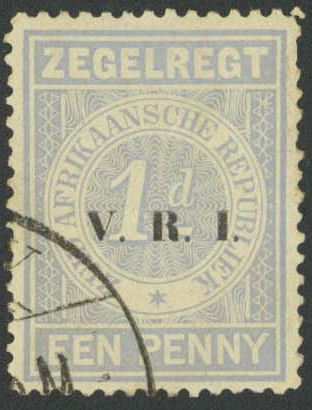 |
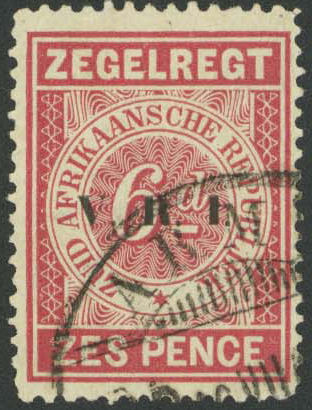 |
 |
| 1d Trans-H1 | 6d Trans-H2 | 1s Trans-H3 |
| Fiscal stamps used telegraphically, images courtesy of Oscar Van der Vliet. | ||
 |
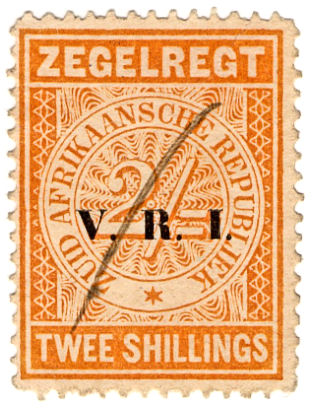 |
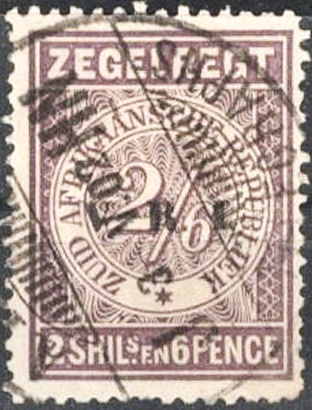 |
| 1s6d Trans-H4 (Source: Andrew Higson) | 2s Trans-H5 (Fiscally used) | 2s6d Trans-H6 (Source: Ian Paterson) |
| I need Telegraphically used images of H4 and H5 if anyone can supply them. | ||
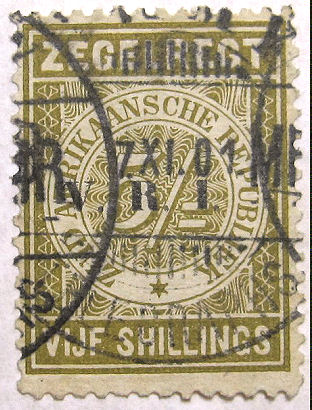 |
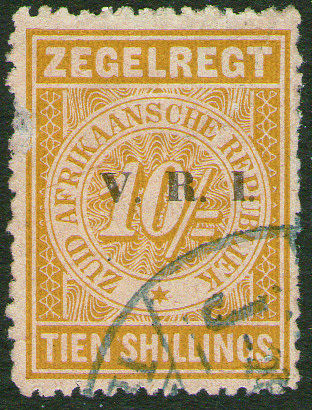 |
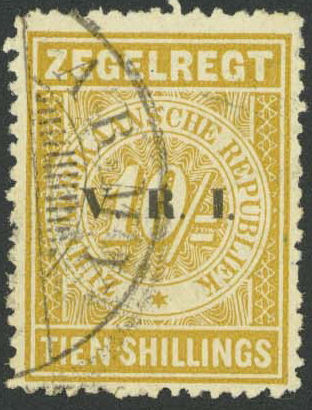 |
| 5s Trans-H7 B 7.XI.01 MR (Balmoral ?) | 10s Trans-H8 Johannesburg Military ( J- HN ) | 10s Trans-H8 |
| Courtesy of Mark Gibson. | One of mine. | A better H8, courtesy of Oscar Van der Vliet |
 |
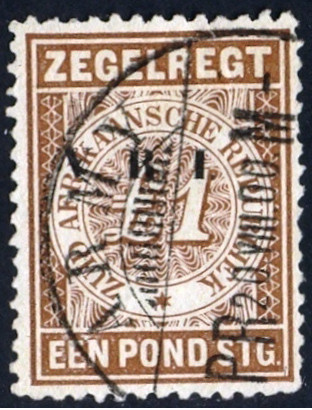 |
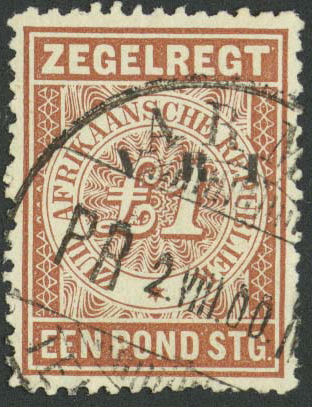 |
| £1 Trans-H9 | £1 Trans-H9 | £1 Trans-H9 |
| Another Johannesburg ( J- HN ) in blue and Pretoria Military. These two scans and the block of 4 x 10s below were kindly supplied by Bram Leeflang | One from Oscar Van der Vliet | |
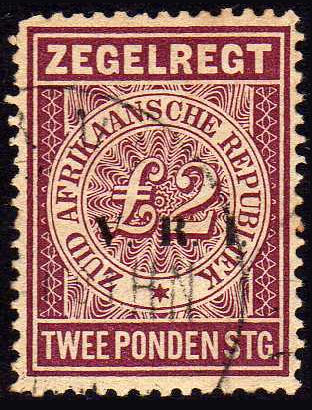 |
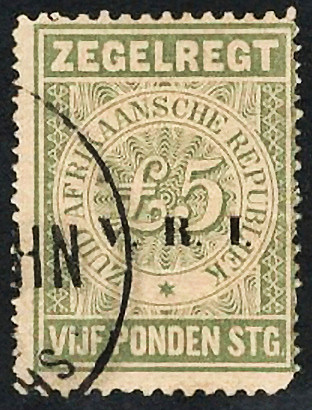 |
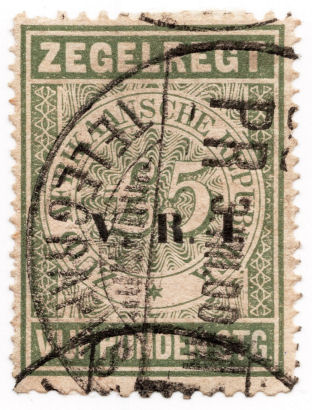 |
| £2 Trans-H10 (Source: Andrew Higson) | £5 Trans-H11 (Source: Ian Paterson) | £5 used at Pretoria Military courtesy Mark Gibson. |
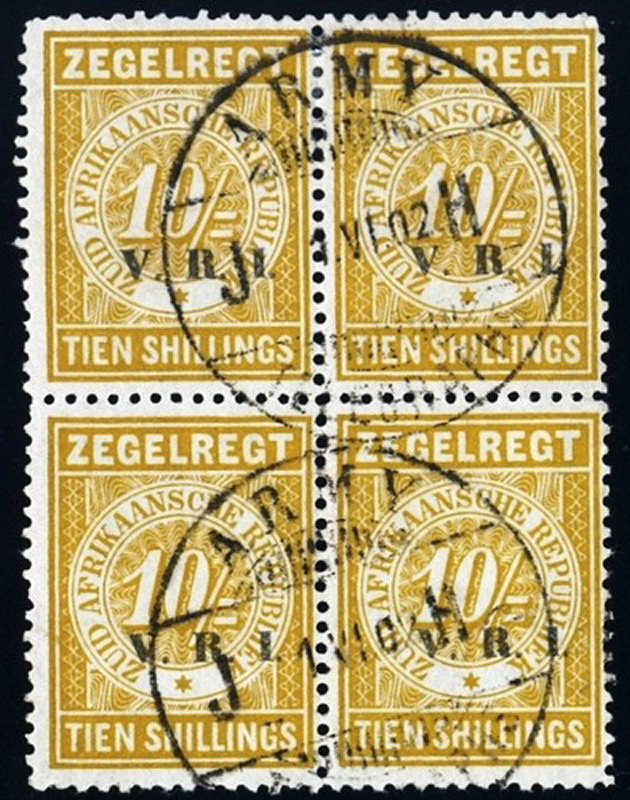 |
| 4 x 10s Trans-H8 dated June 1902, latest known usage - courtesy Bram Leeflang. |
| I presume J H is also Johannesburg, but have not seen it listed. |
Note: Hiscocks designations and prices were regardless of cancels used. My designations are intended to be specifically with GB Army Telegraph cancellations.
Whilst H4 and H5 used are given modest values, AT-Tran-4 and AT-Tran-5 used may be very scarce.
| UDes. | Hisc. | Description | Mint | Used |
|---|---|---|---|---|
| AT-Tran-12 | H1 | 1d light greyish blue, perf. 11½ | 3.00 | 8.00 |
| AT-Tran-12a | H1a | perf. 11½ x 14 | 5.00 | 10.00 |
| AT-Tran-13 | H2 | 6d rose carmine, perf. 11½ | 3.00 | 7.00 |
| AT-Tran-13a | H2a | perf. 11½ x 14 | 5.00 | 10.00 |
| AT-Tran-14 | H3 | 1s light greyish blue, perf. 11½ | 4.00 | 7.00 |
| AT-Tran-14a | H3a | perf. 11½ x 14 | 7.00 | 15.00 |
| AT-Tran-15 | H4 | 1s6d olive-bistre, perf. 11½ | 10.00 | 20.00 |
| AT-Tran-15a | H4a | perf. 11½ x 14 | 15.00 | 30.00 |
| AT-Tran-16 | H5 | 2s orange, perf. 11½ | 10.00 | 15.00 |
| AT-Tran-16a | H5a | perf. 11½ x 14 | 15.00 | 25.00 |
| AT-Tran-17 | H6 | 2s6d dull purple, perf. 11½ | 10.00 | 15.00 |
| AT-Tran-17a | H6a | perf. 11½ x 14 | 15.00 | 25.00 |
| AT-Tran-18 | H7 | 5s bistre, perf. 11½ | 10.00 | 15.00 |
| AT-Tran-18a | H7a | perf. 11½ x 14 | 15.00 | 25.00 |
| AT-Tran-19 | H8 | 10s brown-ochre, perf. 11½ | 10.00 | 15.00 |
| AT-Tran-19a | H8a | perf. 11½ x 14 | 15.00 | 25.00 |
| AT-Tran-20 | H9 | £1 orange-brown, perf. 11½ | 15.00 | 30.00 |
| AT-Tran-20a | H9a | perf. 11½ x 14 | 25.00 | 50.00 |
| AT-Tran-21 | H10 | £2 red-brown, perf. 11½ | 25.00 | 75.00 |
| AT-Tran-21a | H10a | perf. 11½ x 14 | 40.00 | 100.00 |
| AT-Tran-22 | H11 | £5 yellow-green, perf. 11½ | 50.00 | 125.00 |
| AT-Tran-22a | H11a | perf. 11½ x 14 | 50.00 | 125.00 |
Look here for an explanation of the table.
From about September 1901 stamps were overprinted 'Transvaal / Telegraphs' instead of 'V.R.I.' to segregate
them from normal postage/fiscal stamps.
Hiscocks lists 1d, 3d, 4d, 6d, 1s and 2s6d of the series below as H12 to H17.
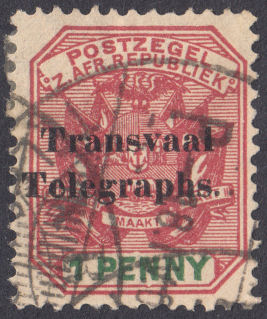 |
 |
 |
| 1d Trans-H12 | 3d Trans-H13 | 4d Trans-H14 |
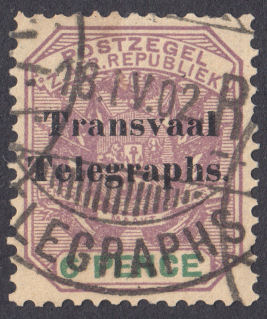 |
 |
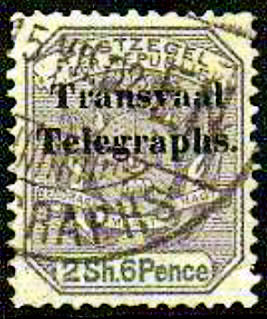 |
| 6d Trans-H15 | 1s Trans-H16 | 2s6d Trans-H17 Source: Andrew Higson |
here are H12, H15, and H17.
Can anyone provide scans of H13, H14 or H16 ?
There are forgeries about. Here is an example:
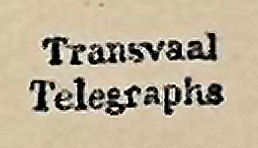
This is a Fournier production
'r' of 'Telegraphs' looks different and no stop on end.
courtesy of James Bendon
(Click on image to see source).
Note: Hiscocks designations and prices were regardless of cancels used. My designations are intended to be specifically with GB Army Telegraph cancellations.
Whilst H13, H14 and H17 used are given high values suggesting they are scarce with ANY cancel. AT-Tran-13, AT-Tran-14 and AT-Tran-17 used will be scarcer or even nonexistent.
It is possible that they only ever existed with forged overprints.
| UDes. | Hisc. | Description | Mint | Used |
|---|---|---|---|---|
| AT-Tran-23 | H12 | 1d carmine-red and green (SG217), perf. 12½ | 35.00 | 50.00 |
| AT-Tran-24 | H13 | 3d purple and green (SG220), perf. 12½ | 20.00 | - |
| AT-Tran-25 | H14 | 4d sage green and green (SG221), perf. 12½ | 20.00 | - |
| AT-Tran-26 | H15 | 6d dull purple and green (SG222), perf. 12½ | 40.00 | 60.00 |
| AT-Tran-27 | H16 | 1s ochre and green (SG223), perf. 12½ | 20.00 | - |
| AT-Tran-28 | H17 | 2s6d grey-lilac and green (SG224), perf. 12½ | 75.00 | 120.00 |
Below is Hiscocks type H18. They are Revenue stamps of Cape of Good Hope overprinted 'TRANSVAAL'.
The 1s value took over from the earlier 1s value and is known used from March 1901 to January 1902.
The 6d value was also used but is much scarcer (not listed by Hiscocks).
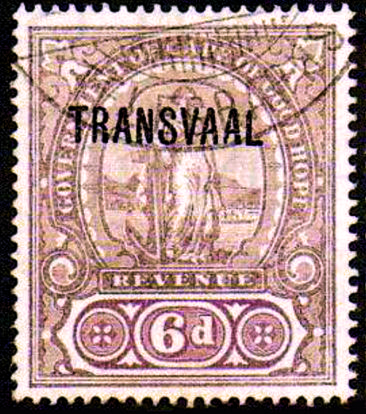 |
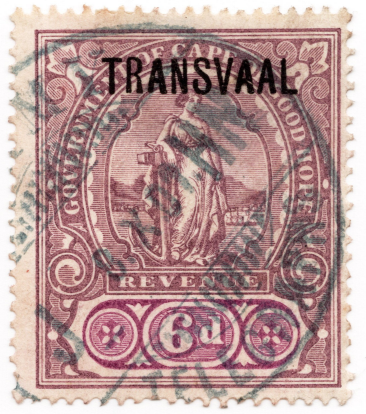 |
| Scarce 6d (Source: Andrew Higson) | 6d example courtesy of Mark Gibson. |
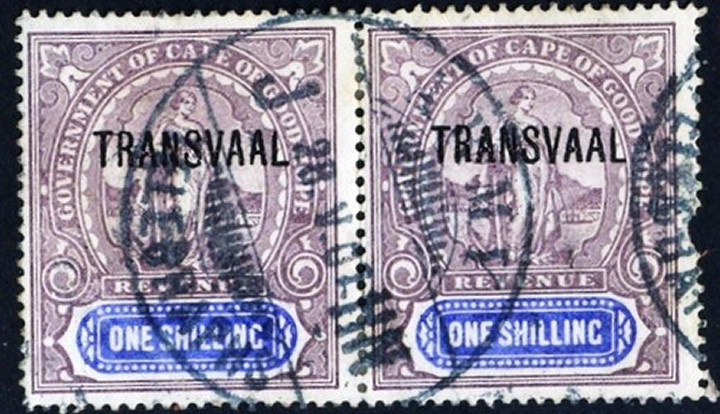
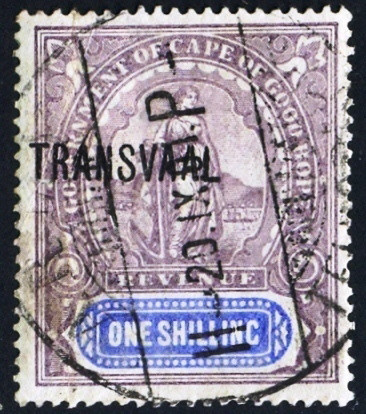 |
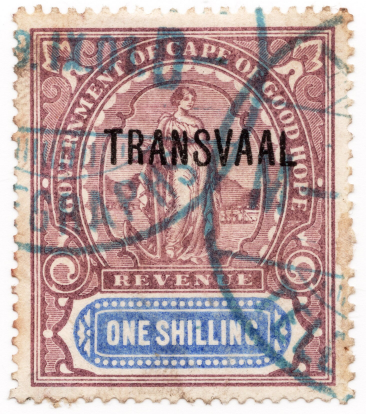 |
| These 1s scans above are kindly provided by Bram Leeflang. a pair from Johannesburg and single from Hectorspruit. | M- D- of Middleburg courtesy of Mark Gibson. |
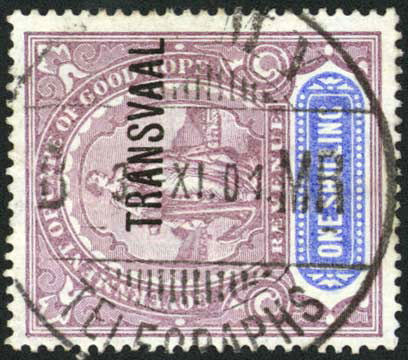 |
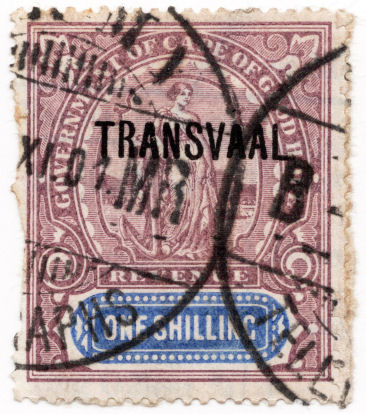 |
| First image from Oscar Van der Vliet showing a B 3-XI-01 MR Another from Mark Gibson. This cancel is of an unknown office. | |
| UDes. | Hisc. | Description | Mint | Used |
|---|---|---|---|---|
| AT-Tran-29 | H18 | 1s lilac and blue, perf. 13½ | 50.00 | 50.00 |
| AT-Tran-29a | 6d dull mauve and lilac, perf. 13½ | 80.00 | 250.00 |
This is a ZAR 2Sh.6Pence overprinted 'Transvaal Telegraphs / - / One Shilling' (1902).
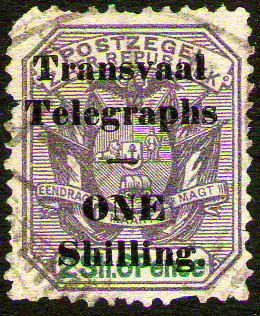 |
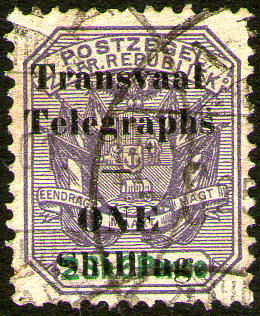 |
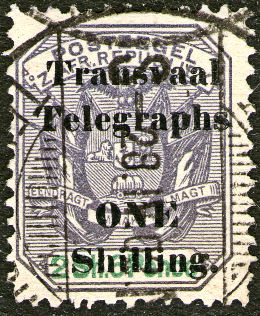 |
| Rather feint but looks like it starts with 'J-' which would make it J- HN for Johannesburg. |
Rather feint but luckily has 2 strikes so all but the month is visible giving -S 25.??.01 -R which presents a puzzle. The only -S -R that I have on the list for South Africa is Elandslaagte in Natal ! Also this is dated 1901, Elandslaagte supposedly closed May 1900. |
Not feint S- 28.IV.02 N- Standerton. |
| 1s on 2/6d Transvaal - H19 | ||
| UDes. | Hisc. | Description | Mint | Used |
|---|---|---|---|---|
| AT-Tran-30 | H19 | 1s on 2s6d grey-lilac, perf. 12½ | 50.00 | 30.00 |
The remaining telegraph stamps listed by Hiscocks are all
overprinted 'Transvaal / Telegraphs'.
They are:
| Trans-H20 | 5s on £2 (H10) |
| Trans-H21 | ZAR 6d overprinted E.R.I. and 'TELEGRAPHS' in italics. |
| Trans-H22 | 1s KEVII Revenue stamp overprinted as types H12 to H17 above. |
| Trans-H23 | 10s KEVII Revenue stamp overprinted similarly but in italics (as H21). |
| Trans-H24 | £1 KEVII Revenue stamp overprinted in italics. |
| Trans-H25 | £5 KEVII Revenue stamp overprinted in italics. |
 |
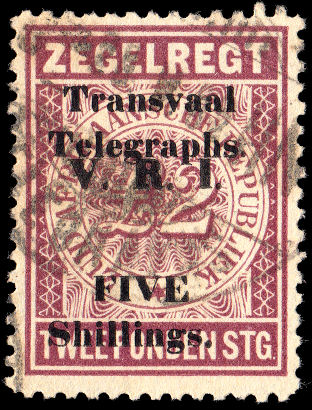 |
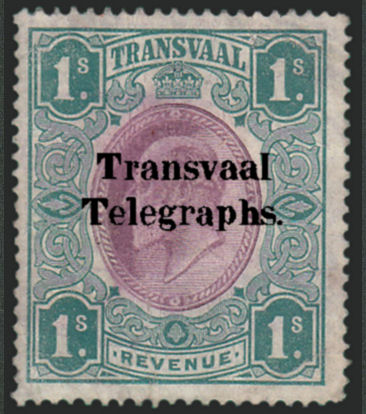 |
| 5s Trans-H20, feint J HN (Source: Andrew Higson) | 5s Trans-H20, another J HN (1902, One of mine) | 1s Trans-H22 mockup |
Can anyone provide a scan of a real H22 ? |
||
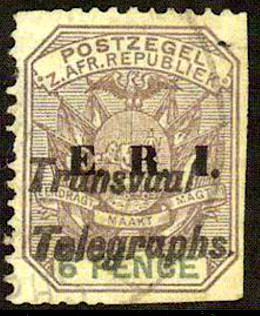 |
 |
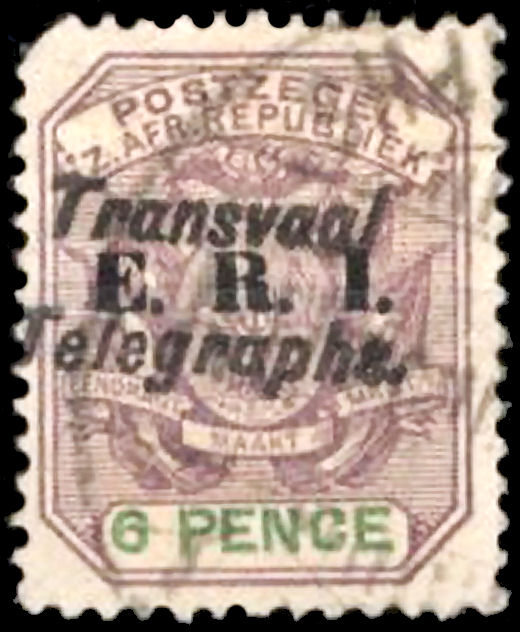 |
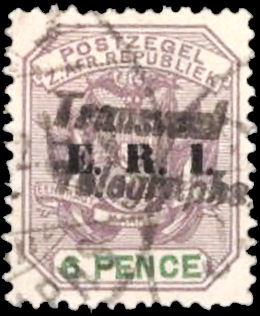 |
| 6d Trans-H21 (Source: Andrew Higson) | 6d Trans-H21 (Source: SandaFayre.com) | 6d Trans-H21 examples (Source: Ian Paterson) | |
Note that these examples all have ARMY TELEGRAPHS cancels. |
|||
| Although looking much 'neater' this is a forgery. Compare letters 'e' and 's', they are much more italic looking. |
|
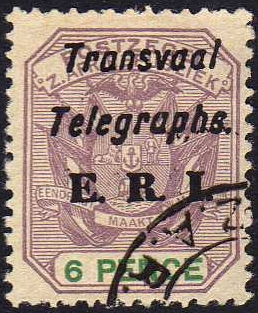 |
It does not look like a Fournier.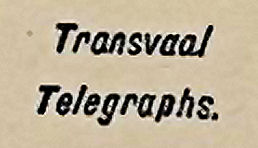 The 'al' of 'Transvaal' looks different and the 'e's and 's' of 'Telegraphs'. |
| Courtesy of Andrew Higson. | Courtesy of James Bendon who has many more Fournier examples for sale. (Click on image to see source). |
 |
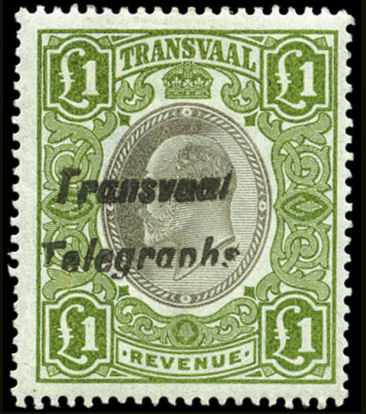 |
 |
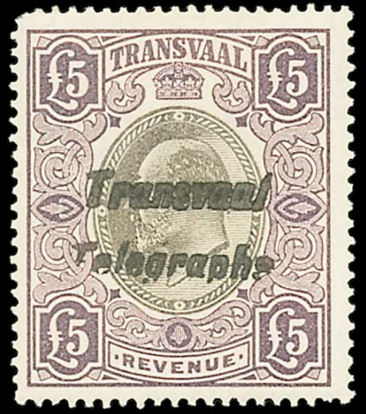 |
| 10s H23, J 31.VII.02.HN (Source: SandaFayre.com) | £1 Trans-H24, Image courtesy of Mark Gibson. | £1 Trans-H24, used courtesy of Ian Paterson. | £5 Trans-H25, Image courtesy of Spink and Son. |
There are many forgeries of these, note the genuine overprints shown above.
There are two different though similar types of this overprint which are illustrated along with Hiscocks H21 on
page 44 of 'The Transvaal Philatelist' v39,no2 (150), May 2004
| UDes. | Hisc. | Description | Mint | Used |
|---|---|---|---|---|
| AT-Tran-31 | H20 | 5s on £2 red-brown, perf. 11½ | 300.00 | 100.00 |
| AT-Tran-32 | H21 | 6d dull purple and green, perf. 12½ | 150.00 | 125.00 |
| AT-Tran-33 | H22 | 1s green and dull purple, perf. 14 | - | - |
| AT-Tran-34 | H23 | 10s blue and grey, perf. 14 | 225.00 | 150.00 |
| AT-Tran-35 | H24 | £1 olive and grey, perf. 14 | 500.00 | 300.00 |
| AT-Tran-36 | H25 | £5 purple and grey, perf. 14 | 1000.00 | 750.00 |
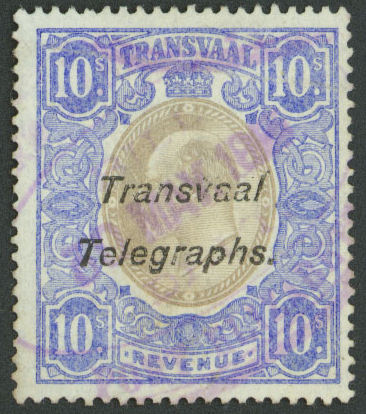 |
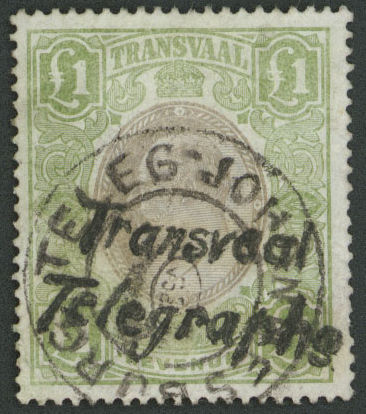 |
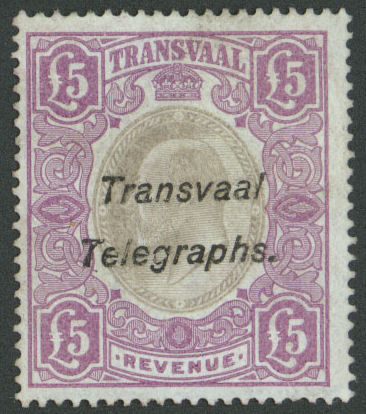 |
| NOT H23, H24 and H25 - These scans with FORGED overprints are kindly provided by Oscar Van der Vliet. Buyers Beware! Genuine above. | ||
Illustrations of type H20 and more forgeries of H23, H24 and H25 can be seen at the bottom of HAVING THE REVENUE ON A LINE.
See also H21 above.
François Fournier (1846-1917) is known to have produced forgeries of Transvaal surcharges and postmarks. A useful reference can be found here:
jamesbendon.com
Apart from stamps shown so far, a number of items are found with Army Telegraph cancels that were either postal use or created for philatelic purposes.
This is another interesting one courtesy of David Wiseman, this on an Army Telegraph Form 295A, but still Germiston.
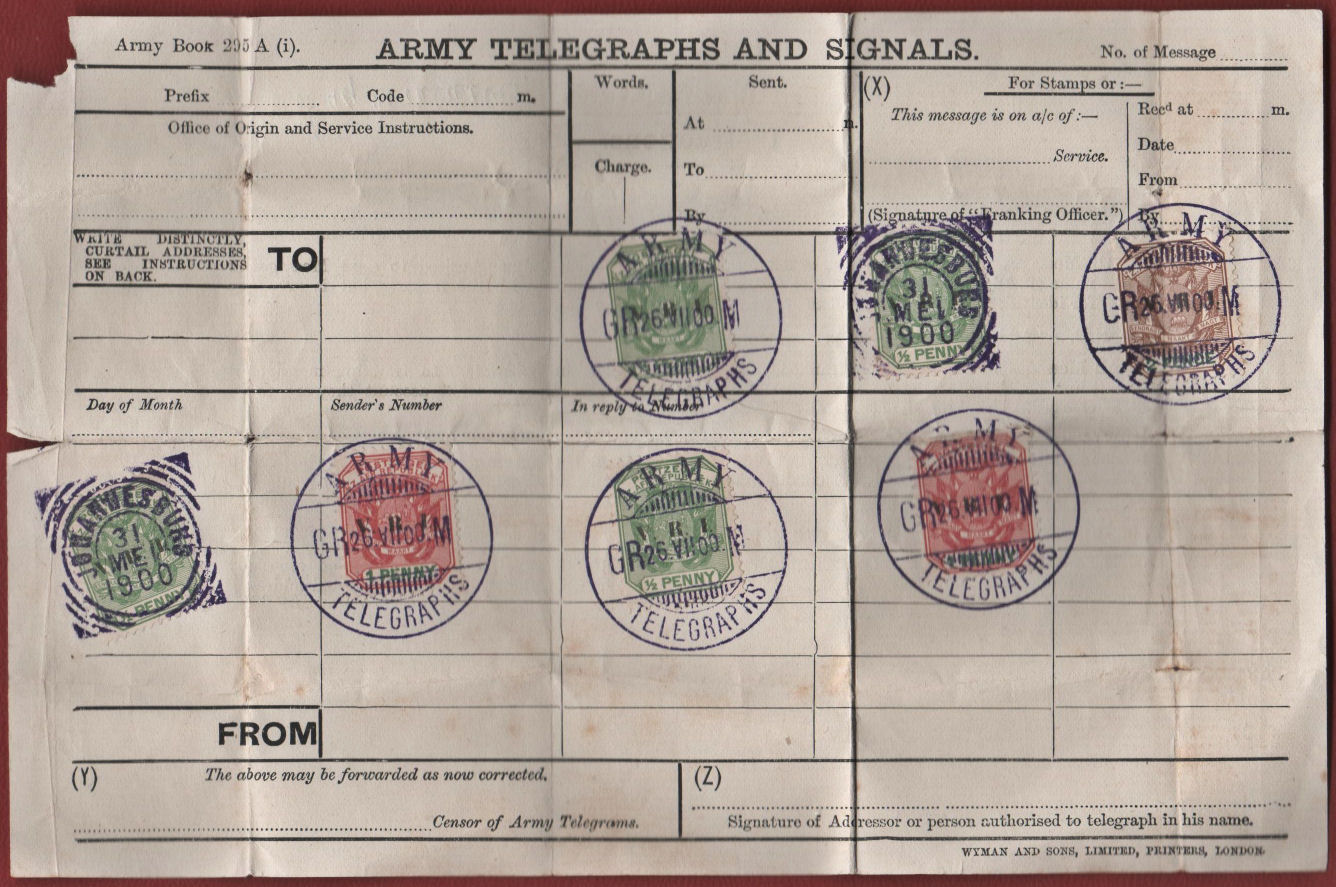
It has 5 stamps totalling 5d (2 x ½d, 2 x 1d, 2d) with GR 26.VII.oo.M Army Telegraph cancels.
It also has another two ½d stamps cancelled with 31 MEI 1900 Johannesburg squared circles that, judging from the positioning,
appear to have been applied after the others despite the earlier date! Why else the odd spacing ? Perhaps it had been unused for a while.
All stamps are 'V.R.I.' but not telegraphic.
Click on the image to enlarge.
For further information on these, see "Army Telegraphs in the Transvaal; an update", The Transvaal Philatelist, v40,no.4(156) Nov.2005 Pg.109
I understand that more similar items are known with a range of values that usually add up to one shilling.
It looks like the first has ½d, 2½d, 3d and 6d adding to 1s, but the second has a total of 6d.
A telegram from Pretoria using a South African Republic form that appears to have been appropriated at Klerksdorp.
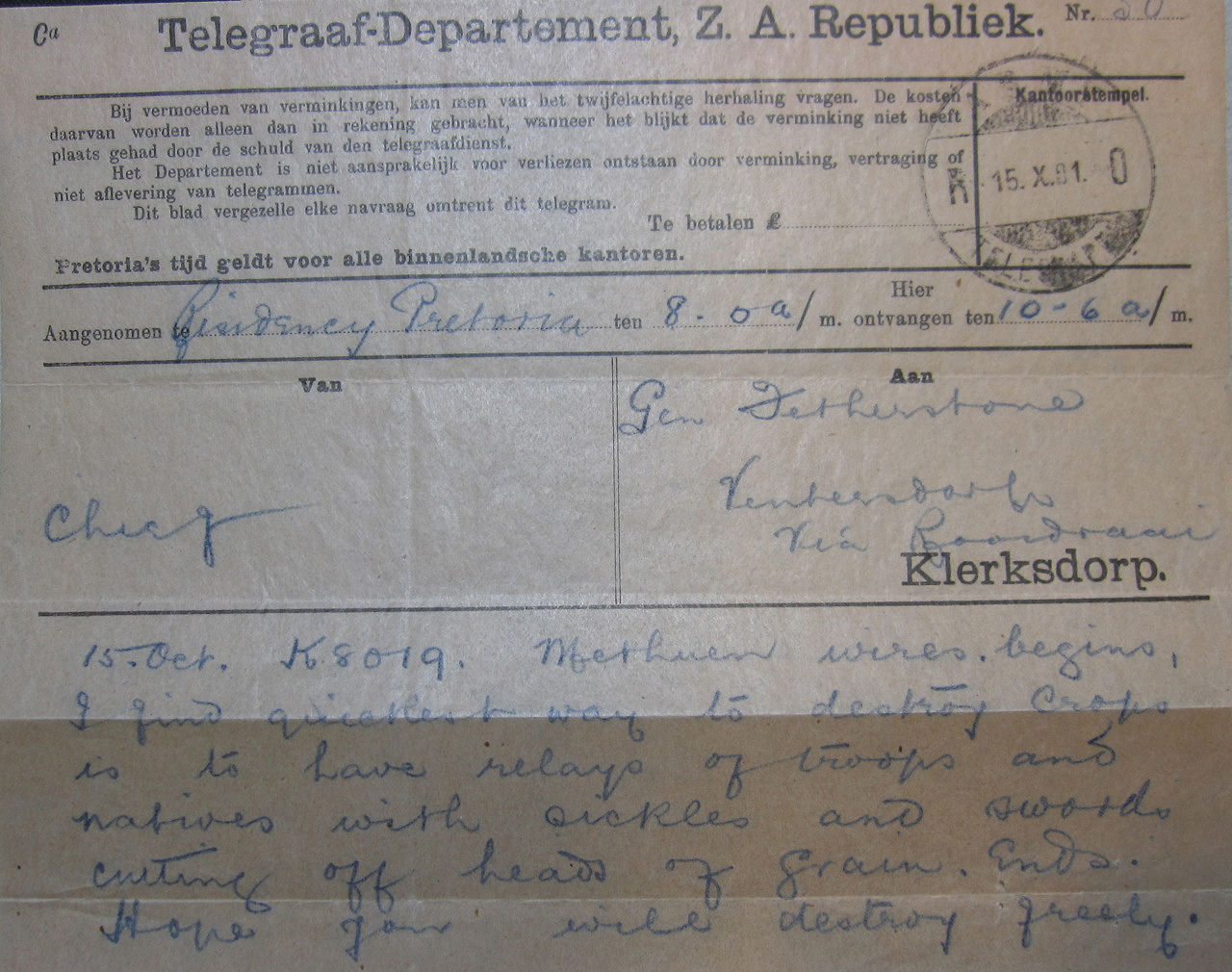
The telegram dated 15/10/1901 details the quickest way to destroy crops. It is estimated that this and similar policies including concentration camps,
led to the deaths of 10% of the population, largely women and children.
It was sent from Residency, Pretoria to 'Ventersdorp Via Rooidraai'. This telegram is forwarding it from Rooidraai to Ventersdorp and is cancelled R- 15.x.01 -O
Ventersdorp is thought to be the code V- TD which supposedly opened on 8/6/00 and closed on 31/7/00 though it is known used 7/1/01
(Lord Kitchener's) Residency, Pretoria is listed as being code PR -K but the item below shows it was initially PR K-
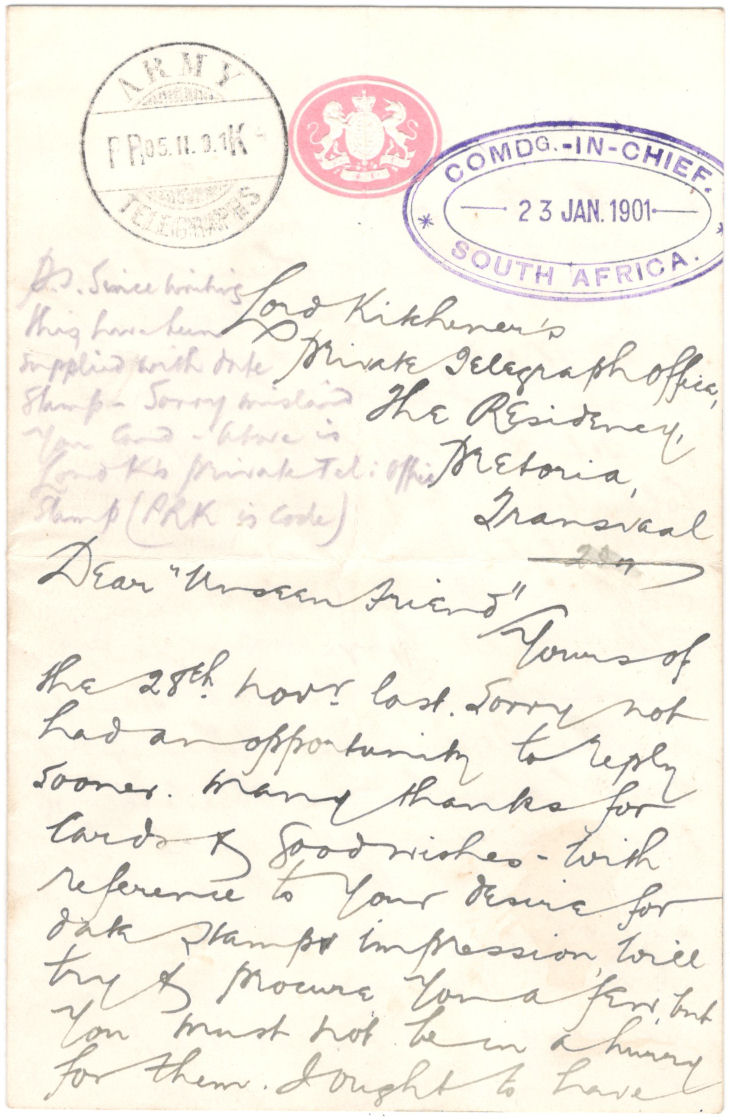

The earliest date for Residency Pretoria that I have been given is 05.11.1901. I suspect that 11 may be a mistake for the Roman numerals II meaning 2,
and that "ABWP 17/4 p117" may be a reference to the item above, and the date given for opening of 29.01.1902 may have been for change of code (perhaps due to change of use).
Strangely, this represents the year as '0.1', perhaps causing the confusion over the month. Images courtesy of Ian Paterson.
Does anyone have an example of Residency Pretoria ?
There is evidence that this cancellation was sometimes used for non-telegraphic purposes (as in the OVS).
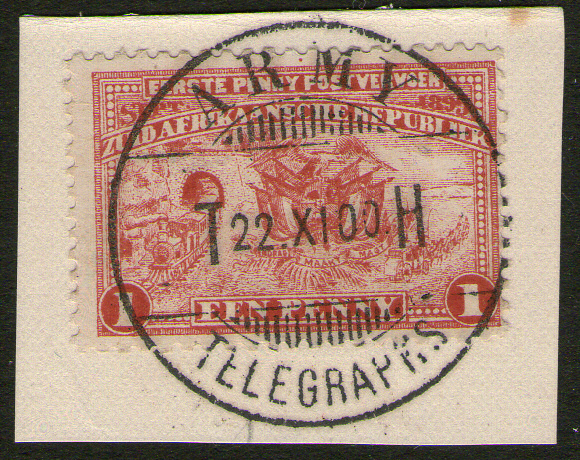
Apparently Taaibosch Camp used their Telegraph cancel to send Xmas Cards on 22.XI.00 !!!
They mostly used ORC stamps though.
Irene Military is also known to have used its canceller for postal purposes ( IR 14.IX.00 M- ).
-W 25.VII.02 D- of Wolmaransstad on O.H.M.S. Army Telegraph envelope C377 - courtesy of Grosvenor Auctions.
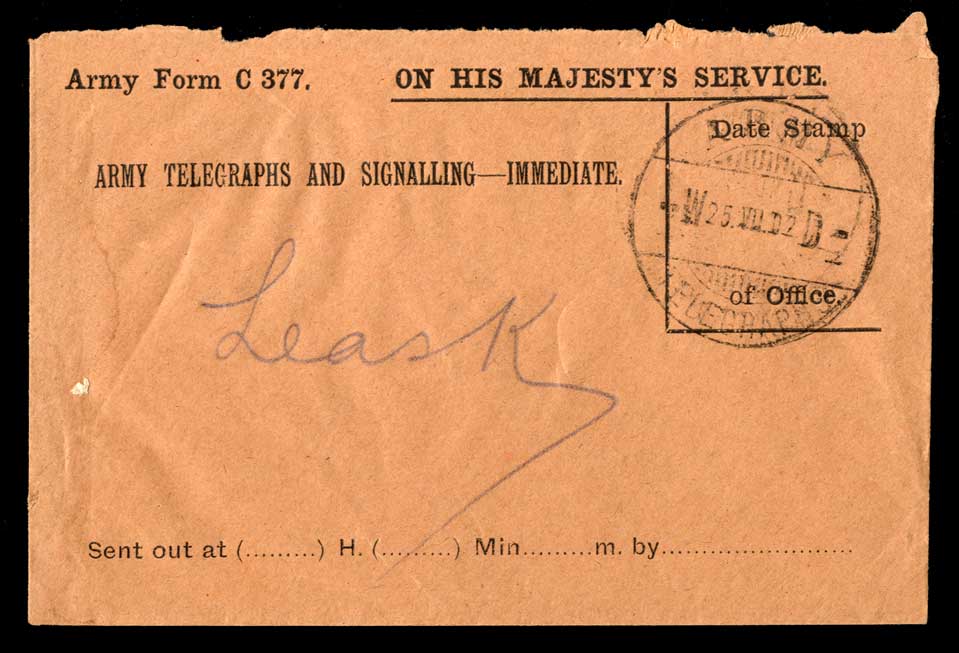
I have listed the items with a reasonable expectation of existence.
Remember this is for Army Telegraphic cancellations other than on Designated Telegraph Stamps.
| UDes. | Description | known | Used |
|---|---|---|---|
| AT-TranC-1 | Army Telegraph Cancel on form or cover, no stamp. | Yes | - |
| AT-TranC-2 | Army Telegraph Cancel on other piece, no stamp. | - | |
| AT-TranC-3 | 1d red 1895 Penny Postage Locomotive (SG215c ?) | Yes | - |
Transvaal Study Circle
Oscar Van der Vliet's article on Revenues that first brought some of these items to my attention.
The Colony and Protectorate of Nigeria was formed at the beginning of 1914 from the Northern Nigeria Protectorate and
the Southern Nigeria Protectorate together with the Lagos Colony.
At the end of World War I it gained some territory on the east side from the former German colony of Kamerun.
I have not seen telegraphically used stamps of Northern Nigeria, but presume that they probably exist.
The cancels I have seen for Nigeria are not strictly speaking Army Telegraphs, though the form of them would seem to be a modification of the Army Telegraph cancels.
I am guessing that these were created in Britain and shipped to Lagos for the purpose. I am uncertain as to whether they were used by military or civil authorities.
I have seen 3 types, inscribed:
'SOUTHERN NIGERIA / TELEGRAPHS' (1910-21),
'S N / TELEGRAPHS' (1915) and
'LAGOS GOVERNMENT / TELEGRAPHS' (1914-17).
SOUTHERN NIGERIA / TELEGRAPHS
An example of a receipt, from Agbor, 1910 with King Edward VII stamps

This form is clearly used in the way common in India and Sudan with the stamps being bisected in use.
This image is courtesy of Andrew Higson. It is half size, click it for a full size version in a new window.
A King George V cover of Saki, October 1918.
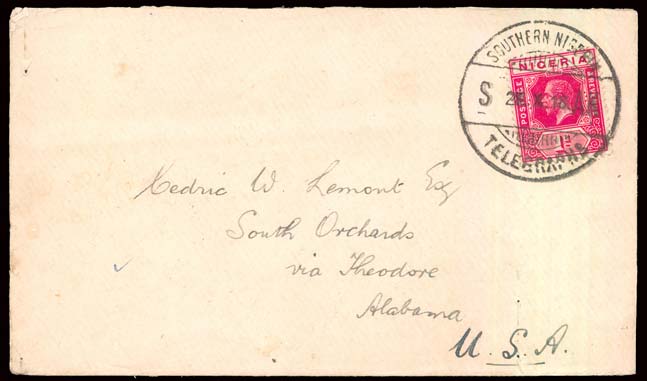
The auction description says: "backstamped Ilesha Oct. 30 and Oshogbo Nov. 2 transit c.d.s.'s
It is understood that this cover results for[sic] an intense period of signals training resulting from the lack of
experienced signallers in the Nigerian brigade sent to reinforce Allied forces in East Africa depleted by sickness."
See: 'Nigerian Brigade info.' - Image courtesy of Grosvenor Auctions.
Port Harcourt.
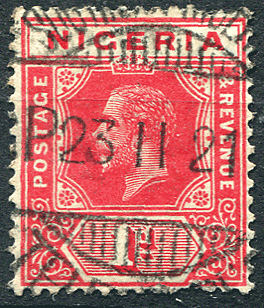 |
 |
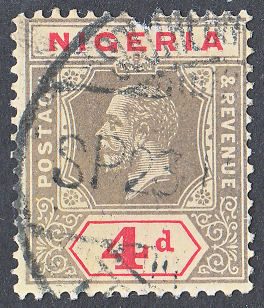 |
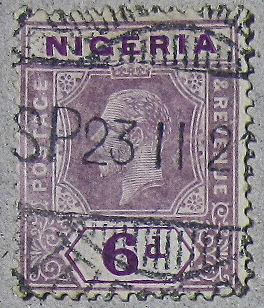 |
| 1d example from 1921 courtesy of Danica Janeckova (lily*19 on eBay) |
2d and 4d of mine (bought from Danica) | 6d Courtesy of Mark Gibson. | |
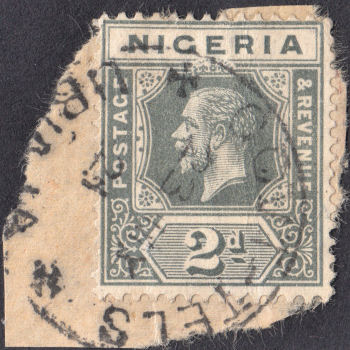
For the sake of interest, here is a 2d cancelled with "GOVT-TELS / UBIAJA", dated 23 MY 21.
Anyone have more examples ?
The following codes are listed in Edward Proud’s book on The Postal History of Nigeria (p.158?).
He also provides these two illustrations:
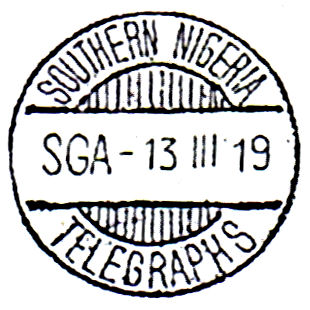
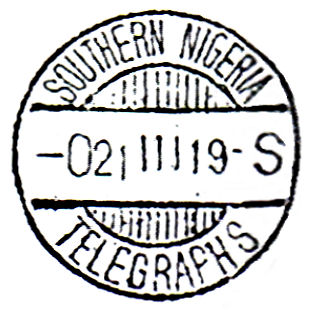
* Known used postally, examples on loose stamps 3d and above should be assumed to be used telegraphically.
** Army Signals, the * above also applies.
LAGOS GOVERNMENT / TELEGRAPHS
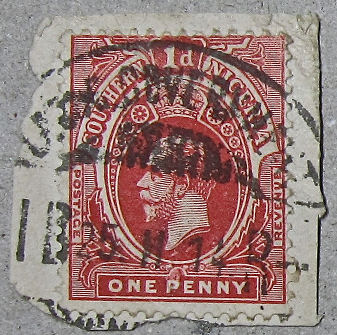
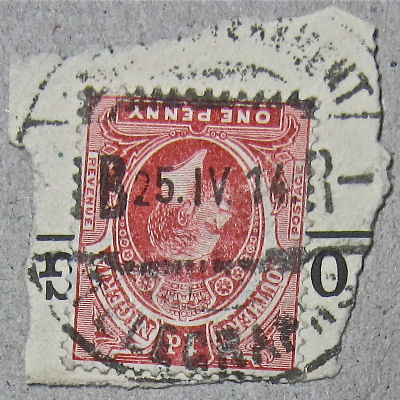 |
 |
| These two are dated 2 months apart with the same telegraph code of Ibadan Residency. Around the top is 'LAGOS GOVERNMENT' Images courtesy of Mark Gibson. |
This later one of 1917 shows that it is Lagos Government Telegraphs. SHA is not on the list above. Image courtesy of Andrew Higson. |
S N / TELEGRAPHS
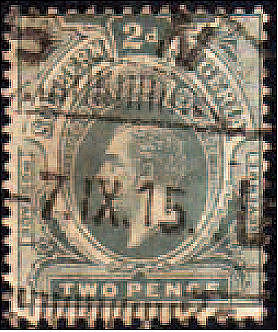 |
This later one of 1915 has the top part replaced by 'S N' The last 'S' of 'TELEGRAPHS' can just be seen at the bottom. The date is 7.IX.15 which is too late for a Güller production. Only the last 'U' of the code can be seen ('Yoruba ?). Was this the fore-runner of the similar cancel inscribed 'SOUTHERN NIGERIA / TELEGRAPHS' as shown below with code S 25.X.18 AK courtesy of Grosvenor Auctions. I understand these were used until 1921 at least. |
Since the same stamps were generally used with the different cancels,
I will combine the list and add a suffix for the type of cancel used.
The basic number will be for the SOUTHERN NIGERIA cancel, with 'S' added for the S N cancel and 'L' for the LAGOS cancel.
ARMY / SIGNALS
An O.H.M.S. Envelope of 1955 using a "(Lablot). Code 7.29.0." Economy Label, though it seems not to have been used according to the instructions.
It was Certified Official and sent from B Company, 5 Nigerian Regiment at Ibadan on 6 September 1955, Arriving at Lagos 2 weeks later, to be sent on to the War Office in London.
The Army Signals cancel is coded "BD . . . LD" which, alone, would not give much clue to the location.
Images courtesy of Anders Uggla.
Stamps of East Africa and Uganda were overprinted GER from 1917 to 1922.
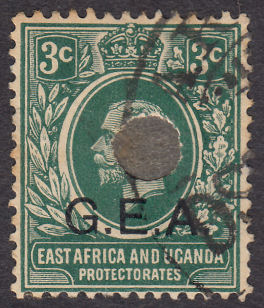
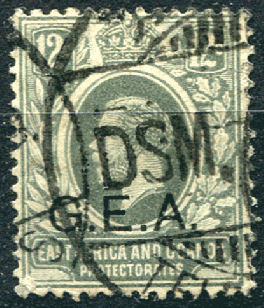
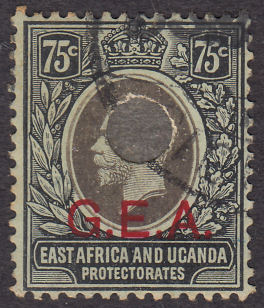
DSM is presumably Dar es Salaam. Some were additionally punctured in use and the 75c here has an 'Army Signals' cancel.
The 12c image is courtesy of Danica Janeckova
The Army Signals cancels were in use by 1921, these dated 9.IV.21.

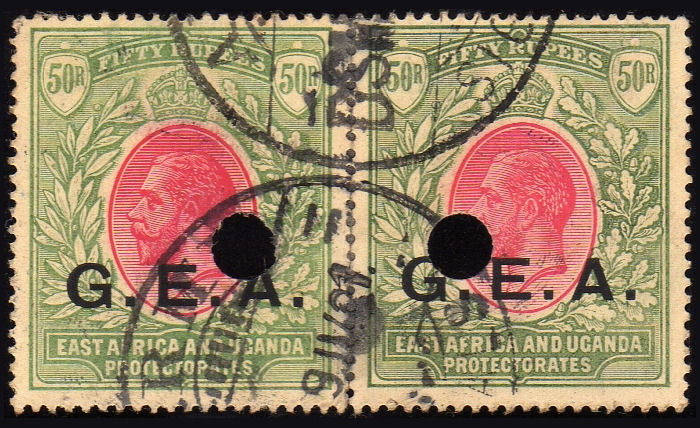
Army Signals cancels are larger and often in mauve. The left one is mine, the right image is courtesy of Andrew Higson.
In the listing, I will take ARMY TELEGRAPHS as the default and add ARMY SIGNALS with an 'S' Suffix.
SIGNALS
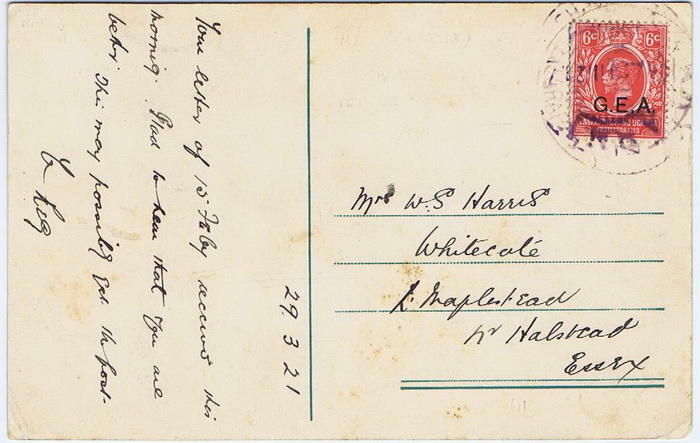 |
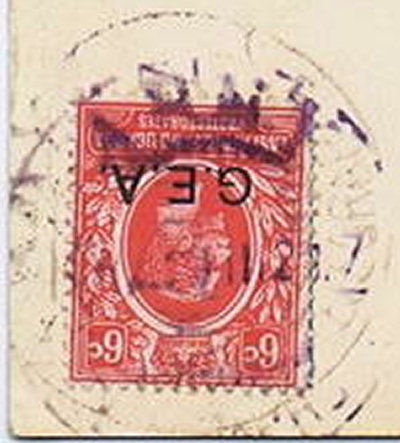 Hard to make out, but said to be "ARMY TELEGRAPHS K W A 29 III 21, struck in violet." Used at KILWA - Source D.Morrison Ltd. |
A failed attempt to suppress the Mahdi uprising in Sudan required the use of these stamps. These were unusual in that due to the urgency, the leads used in the overprinting
were of a reduced "temporary" size (a third) compared to the later permanent versions.
The pence leads had 40 impressions out of the later 120.
The shilling leads had 28 impressions out of the later 84.
The pound leads had 20 impressions out of the later 60.
| Egypt 1884 - 1886 | shown | |
|---|---|---|
| -- | Cairo | |
| LL | Luxor Legal ? (No.25) ? (9.5.1885) | |
"Army Book, 295c." form printed by Harrison & Sons, London and completed in Arabic.
Like Cairo, the cancel is in black, rather than the usual purple.

The date is said to be "9 MAY" with apparently no year. It is to the Council of Egyptian Decisions.
The code is LL which is thought to be Luxor Legal. - Image courtesy of Andrew Higson.
| Shortcuts to different sections | |||||
| 1894 | 1895 | 1897 | 1898 | On Forms | Other |
This laid the telegraphic foundation for advancing from Egypt into the Sudan.
Wadi Halfo was at the north of the Sudan.
"Army Book, 295c.", this from Cairo to Wadi Halfa used 10 February 1885 (image in black & white).
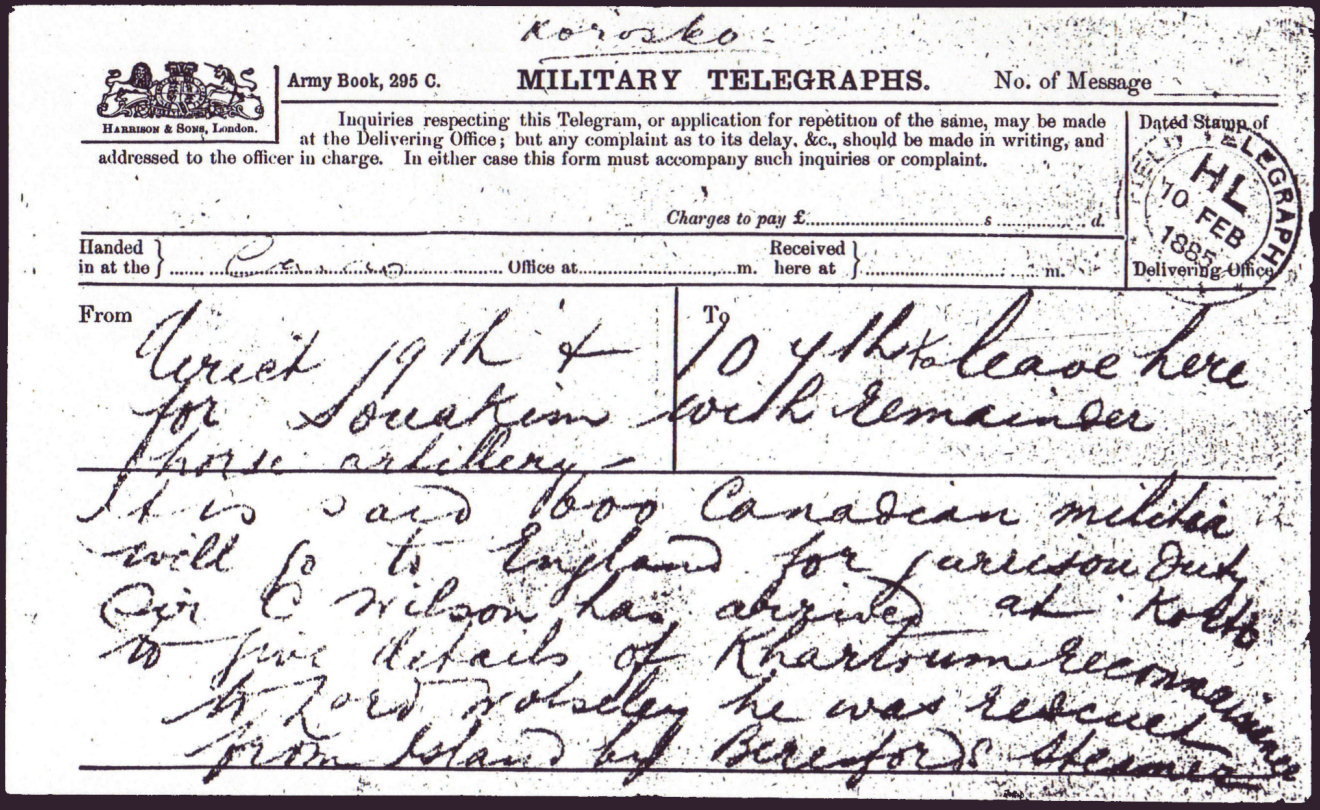
This was used on the same day as the different one mentioned by L & H on page 81- Image courtesy of Richard Stock.
The requirements of accounting for non-military use of their facilities necessitated the use of stamps.
The same stamps were used as shown under Bechuanaland at the top of this page, and various offices were opened, using their own codes as shown in the table.
A selection of Military Telegraphs, used at Quarantine Island.
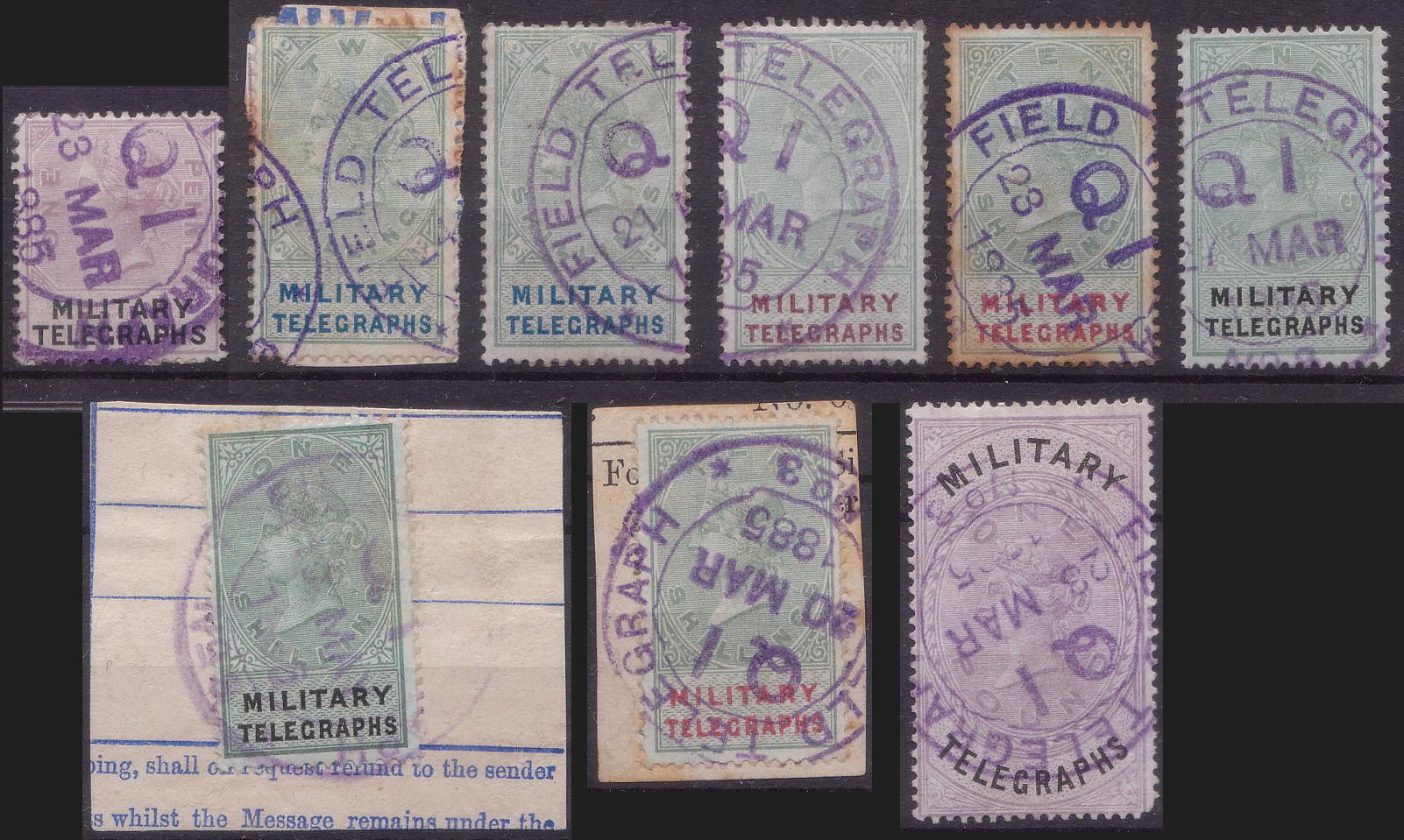
'QI' - Courtesy of Steve Lawrie.
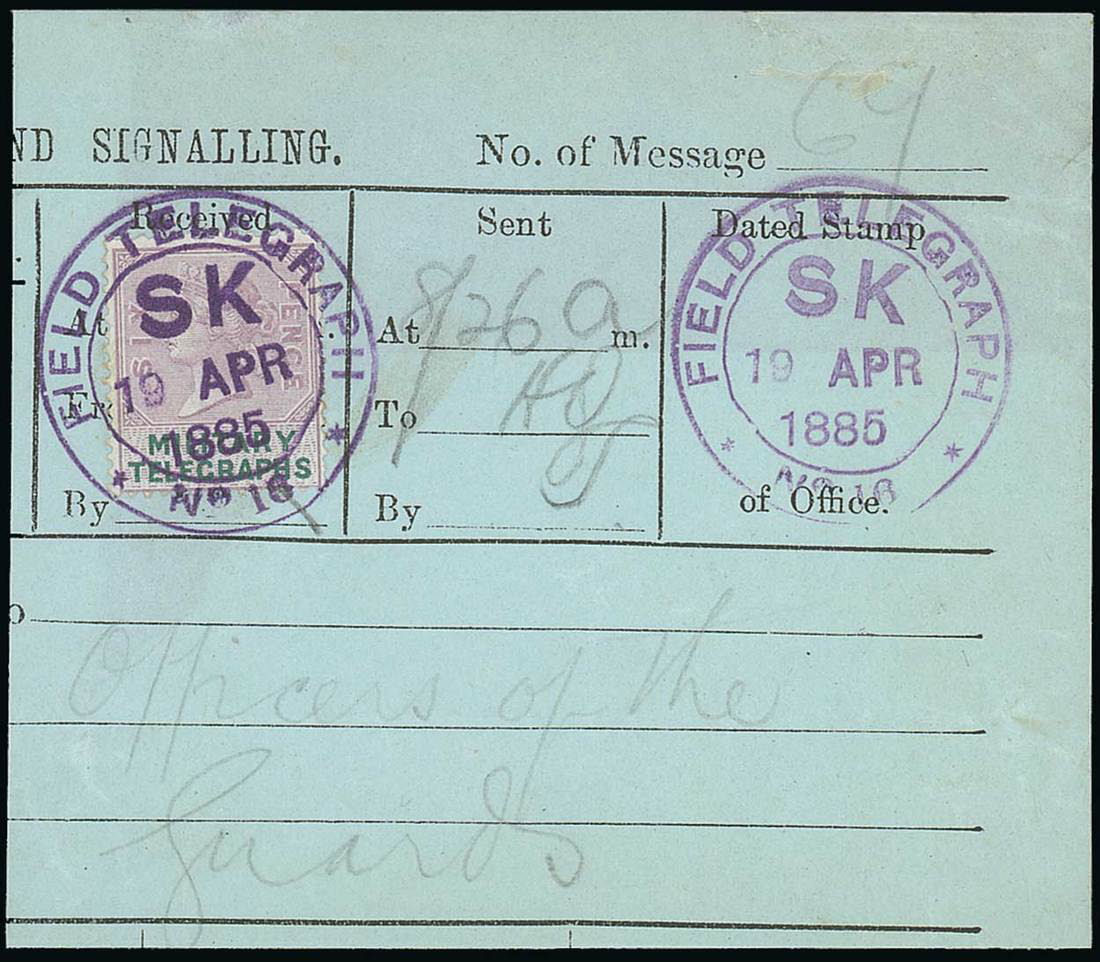
Another example, but clearly on a different kind of form. - Ex. Andrew Higson.
Image courtesy of Spink & Son.
There was a problem with the above, in that what was needed were stamps in the local currency.
Initially, stamps were overprinted locally in Cairo.
The last three are specimens courtesy of Steve Lawrie.
There was a problem with these too, in that overprinting previously gummed sheets in very humid conditions was problematic.
Egyptian stamps overprinted السودان / SOUDAN (Sudan in Arabic and French) were available since 1 March 1897 in the Sudan.
These were used initially (pre-provisional, not listed by Hiscocks) for Army Telegraphs and examples of them are known from June 1897 according to Langmead & Huggins.
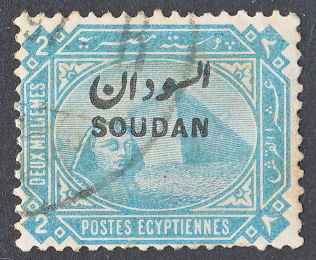 |
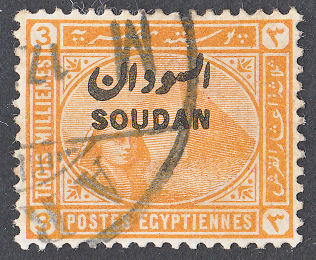 |
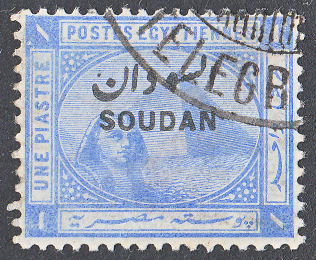 |
| AT-Sud-2 | AT-Sud-3 | AT-Sud-5 |
| UDes. | Hisc. | Description | Known | Mint | Used |
|---|---|---|---|---|---|
| AT-Sud-1 | 1 mil dark brown (SG2) | 1.70 | 80.00 | ||
| AT-Sud-2 | 2 mil blue-green (SG3) | Yes | 1.70 | 80.00 | |
| AT-Sud-3 | 3 mil yellow (SG4) | Yes | 1.20 | 80.00 | |
| AT-Sud-4 | 5 mil carmine (SG5) | 1.50 | 10.00 | ||
| AT-Sud-5 | 1 pias blue (SG6) | Yes | 6.00 | 10.00 | |
| AT-Sud-6 | 2 pias orange-brown (SG7) | 37.00 | 15.00 | ||
| AT-Sud-7 | 5 pias grey (SG8) | 30.00 | 20.00 | ||
| AT-Sud-8 | 10 pias mauve (SG9) | 22.00 | 30.00 |
There are many forgeries of this overprint, identification is made harder by the variability of it.
In combination with a (presumed genuine) Army Telegraph cancel gives more credibility.
(It is much less convincing with an Egyptian cancel)
Some blocks of stamps, courtesy Spink and Son.
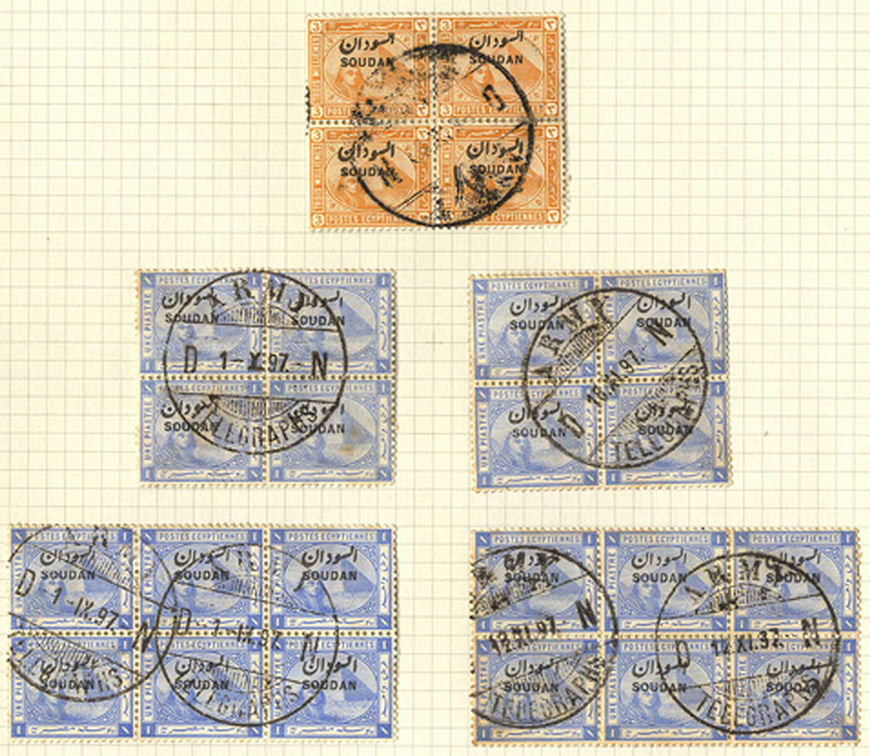
Soon after (L & H give 14 September 1897 as earliest known use) the stamps were additionally overprinted 'TEL' in a horizontal oval (provisionals).
All values (1m, 2m, 3m, 5m, 1p, 2p, 5p and 10p) exist with a black overprint (Hiscocks 1-8),
additionally the 5m, 1p, 5p and 10p exist with a blue overprint (Hiscocks 9-12). These overprints can be quite feint.
Note: Forged 'TEL' overprints exist John Barefoot says:
"Forgeries are often seen, and tend to be neater than the original,
and often with TEL in thinner letters. On the genuine stamps, the letter 'T' of 'TEL' is always longer than the other two letters".

Neatness is not something easily quantified, but the cancel can give you a hint. The rest I agree with.
Compare this to the other examples. The Soudan overprint looks genuine though.
Image of 10p with forged 'TEL', courtesy of Armen on eBay.
| H4 |

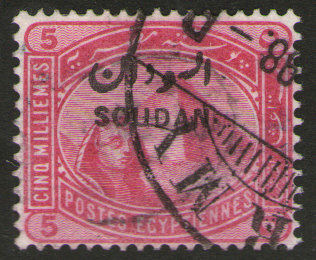
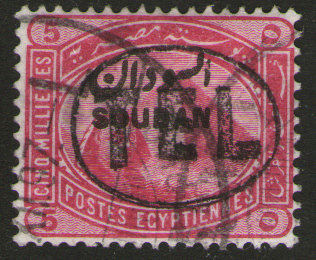 |
| H5 | 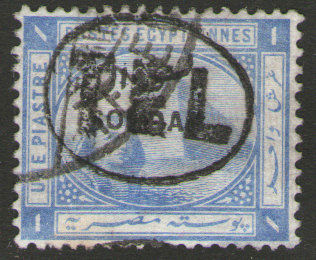 |
| H6 | 

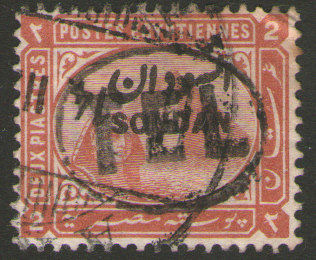 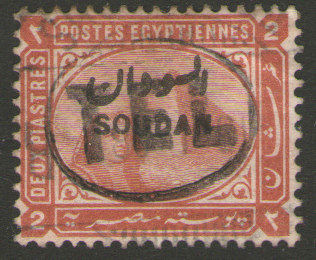
 |
| H7 | 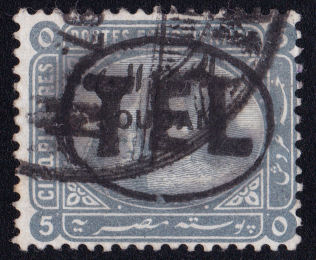
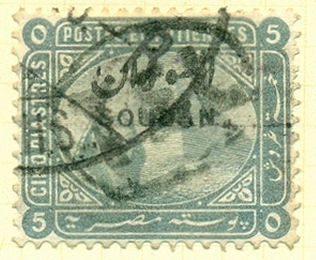 |
| H9 | 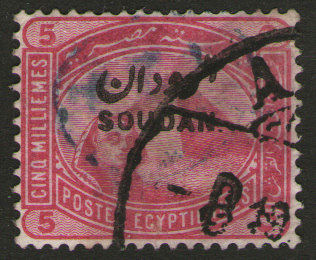
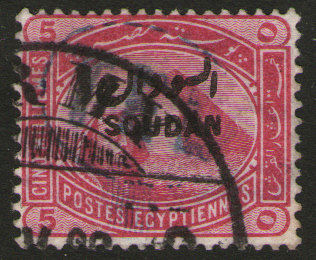
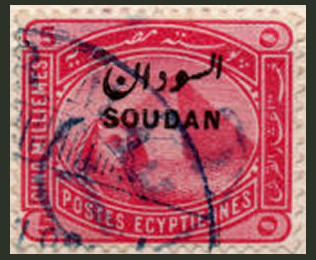 |
| H10 & H11 |
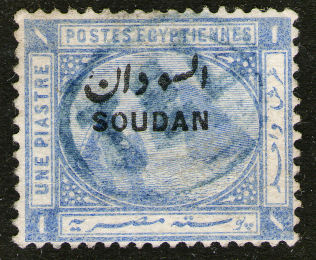 |
 Courtesy of Mark Gibson. |
 5p with blue cancel, courtesy of Armen on eBay. |
An unused selection, courtesy Spink and Son.
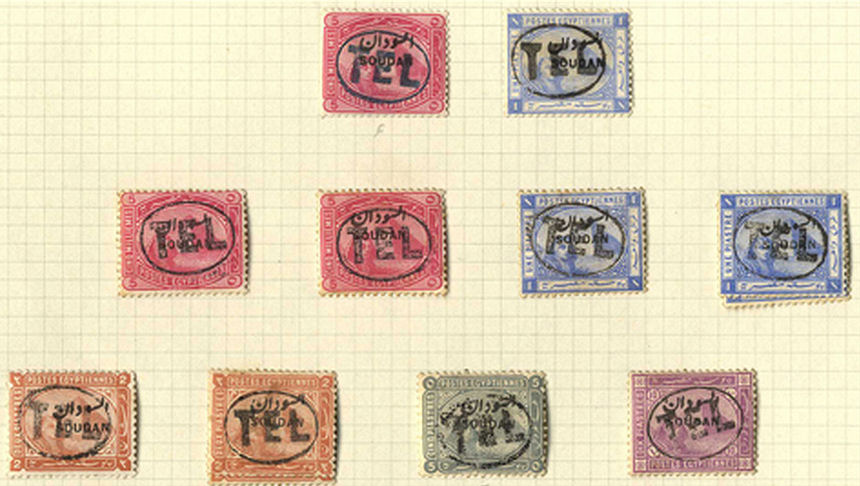
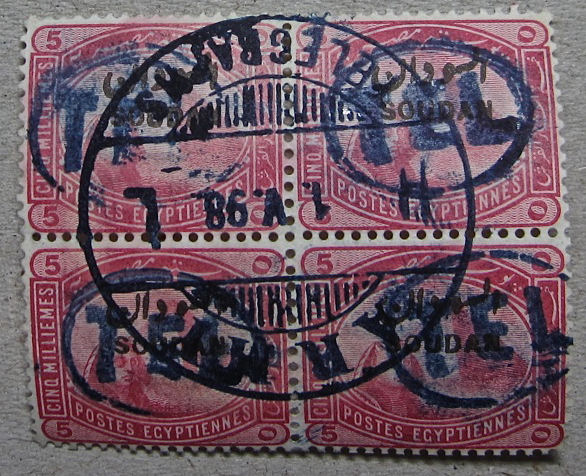
This is a block of H9 stamps used at Halfa on1st May 1898 - courtesy of Mark Gibson.
It is interesting in that the 'ELE' of 'TELEGRAPHS' and part of the date seem to be partly in the same ink as used for the 'TEL' overprint !
Were overprint and cancel applied at the same desk and the canceller had hit the wrong pad first ?
Special Military Telegraph stamps were provided 1 March 1898 with central perforation for easy bisection.
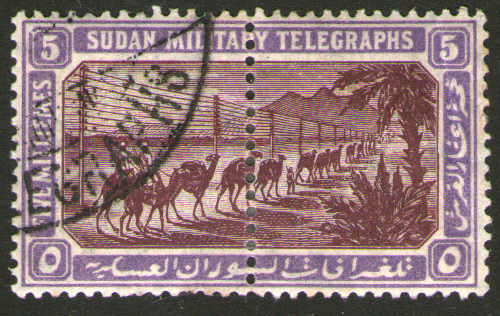 |
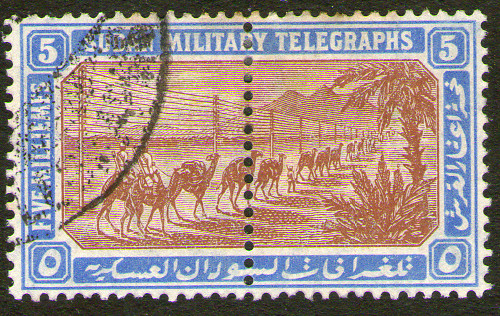 |
| Sudan-H18 | Sudan-H19 |
| - | |
 |
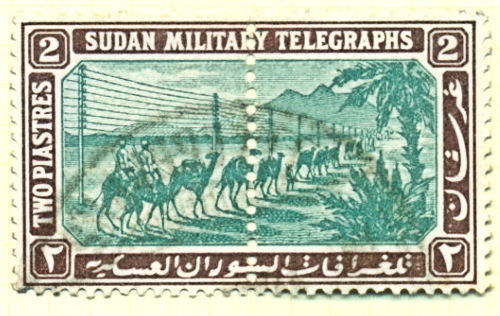 |
| Sudan-H20 | Sudan-H21 |
| - | |
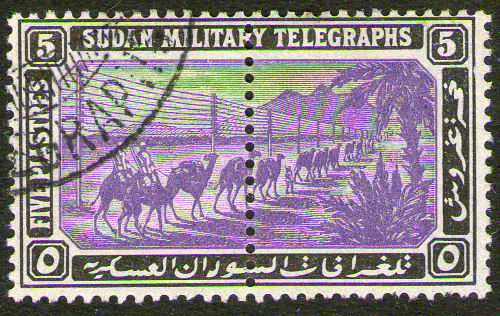 |
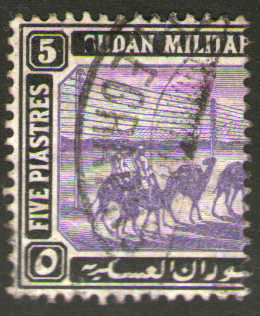
 |
| Sudan-H22 | Sudan-H22 separately used halves |
| - | |
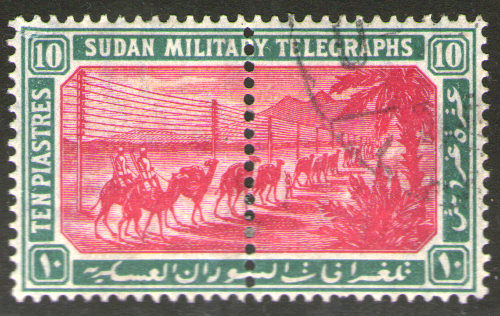 |
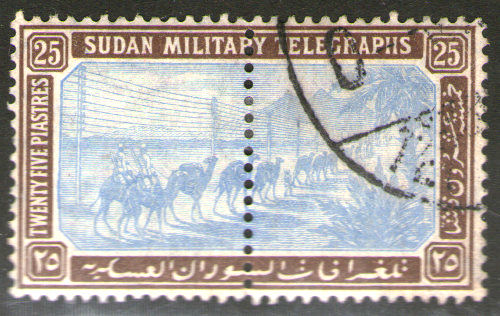 |
| Sudan-H23 | Sudan-H24 |
These exist with 3 watermarks,
| initially (1 March 1898) the 'rosette' for 5m, 1p, 2p and 5p values (Hiscocks 13-16). |
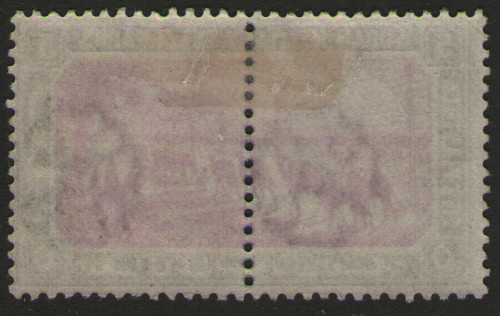 |
| Followed by the Egyptian Star and Crescent (as used on the pyramid and sphinx series) June 1898, only used for the 10p value (Hiscocks 17, scarce). |
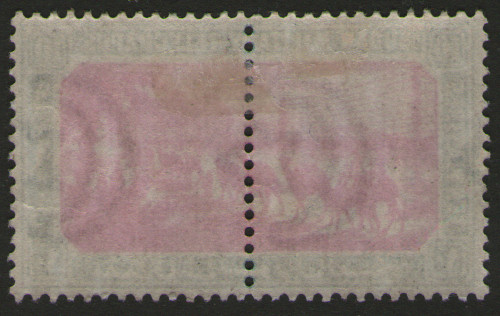 |
| Lastly (Sept 1898 for 10p, 1899 for the rest) by the Sudanese Star and Crescent for the 5m, 1p, 2p (scarce), 5p, 10p and 25p (Hiscocks 18-24). |
 |
I have to say that given the obvious importance of cancelling both halves, I wonder why so many have only half cancelled.
Were a lot of them cancelled to order perhaps ?
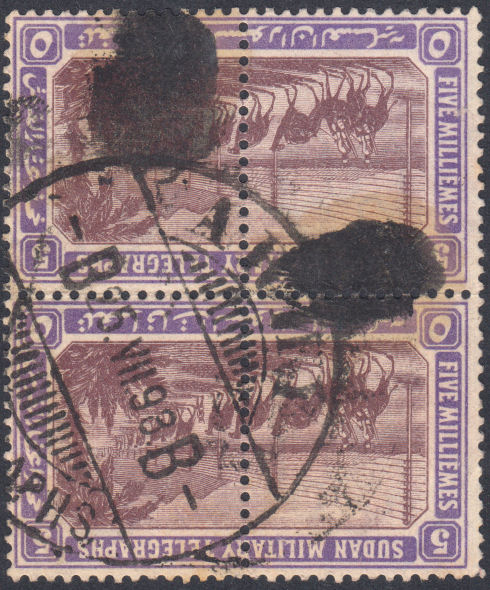 |
 |
| A couple of 5m stamps with a Berber cancel. | A couple of 1 piastre stamps on piece with Khartoum cancel. Courtesy of ibredguy.co.uk. |
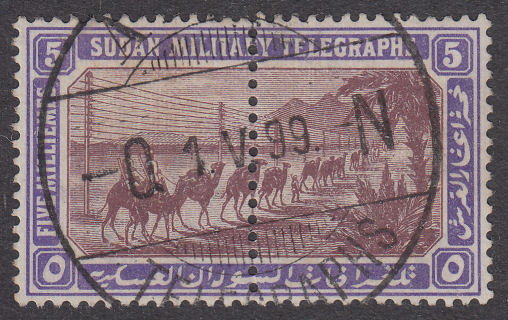 |
 |
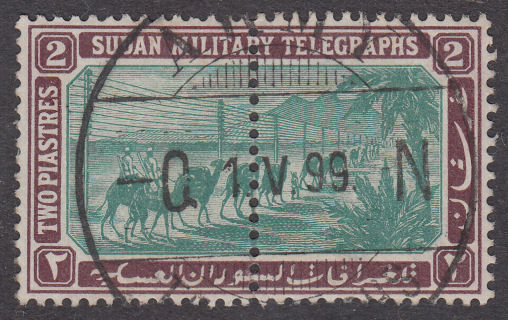 |
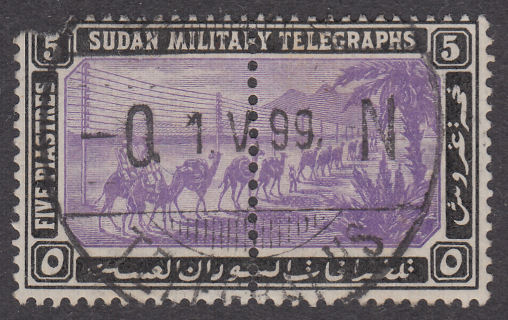 |
| This is -Q -N which could easily be confused with the O N below. I have not heard of it before. I recently got the (rosette wmk.) set of these all together in an eBay lot. They all have the same date so were probably 'by favour'. |
|
| UDes. | Hisc. | Description | Mint | Whole Used | Half Used |
|---|---|---|---|---|---|
| AT-Sud-21 | H13 | 5 mil lilac-brown and violet | 15.00 | 15.00 | 5.00 |
| AT-Sud-22 | H14 | 1 pias black and red | 15.00 | 15.00 | 5.00 |
| AT-Sud-23 | H15 | 2 pias green and lilac-brown | 15.00 | 15.00 | 5.00 |
| AT-Sud-24 | H16 | 5 pias violet and black | 10.00 | 15.00 | 5.00 |
| UDes. | Hisc. | Description | Mint | Whole Used | Half Used |
|---|---|---|---|---|---|
| AT-Sud-25 | H17 | 10 pias rose and green | 40.00 | 100.00 | 25.00 |
I have reduced the mint price on these due to several recent finds of mint blocks and a sheet.
| UDes. | Hisc. | Description | Mint | Whole Used | Half Used |
|---|---|---|---|---|---|
| AT-Sud-26 | H18 | 5 mil lilac-brown and violet | 5.00 | 10.00 | 4.00 |
| AT-Sud-27 | H19 | 5 mil brown and pale blue | 10.00 | 15.00 | 5.00 |
| AT-Sud-28 | H20 | 1 pias black and red | 5.00 | 10.00 | 4.00 |
| AT-Sud-29 | H21 | 2 pias green and lilac-brown | 37.50 | 50.00 | 12.00 |
| AT-Sud-30 | H22 | 5 pias violet and black | 5.00 | 10.00 | 4.00 |
| AT-Sud-31 | H23 | 10 pias rose and green | 7.50 | 10.00 | 4.00 |
| AT-Sud-32 | H24 | 25 pias pale blue and brown | 10.00 | 15.00 | 5.00 |
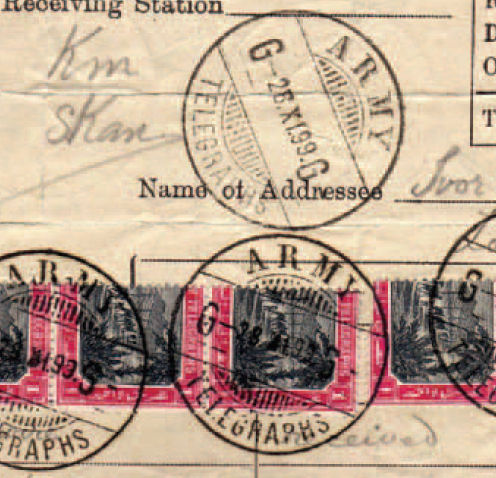 |
| G- 28.XI.99. G- unknown location with a total of 134 half-stamps. (Source: Andrew Higson) |
A Form No. 1. from "S- -O", possibly Sobat, to Cairo used 7 March 1901 (earliest known use ?)

Image courtesy of David Sher.
Army Form No. 2 Tele.
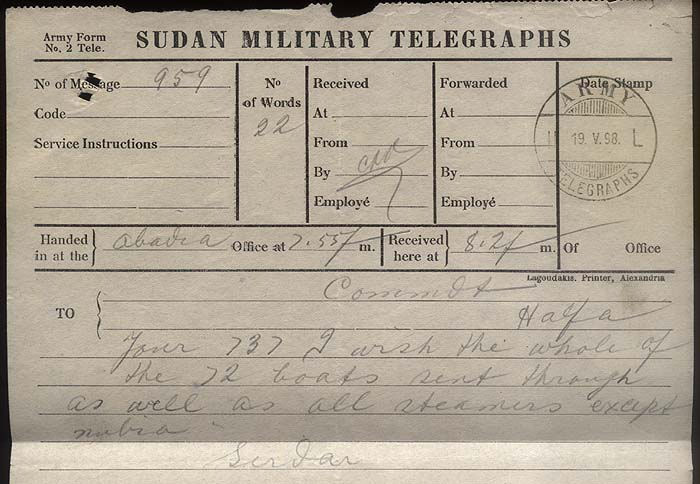
This is a Telegraph received at Wadi Halfa with cancel 'H 19.V.98 L' on a complete form. The telegraph was sent from the Sirdar at Abadia.
This was shortly after the battle of Abadia on 8/4/98, the turning point in the conquest of Sudan, and the Sirdar (Kitchener) was requesting boats (except SS.Nubia a 430ft P&O passenger steamer).
The Battle of Omdurman (across the Nile from Khartoum) on 2/9/98 was a defeat for Mahdist forces by Kitchener
(with the support of gunboats on the Nile).
Image: courtesy of Stephen Murray, Professional Philatelic and Archive dealer with an eBay shop.
Another Telegraph from the Sirdar
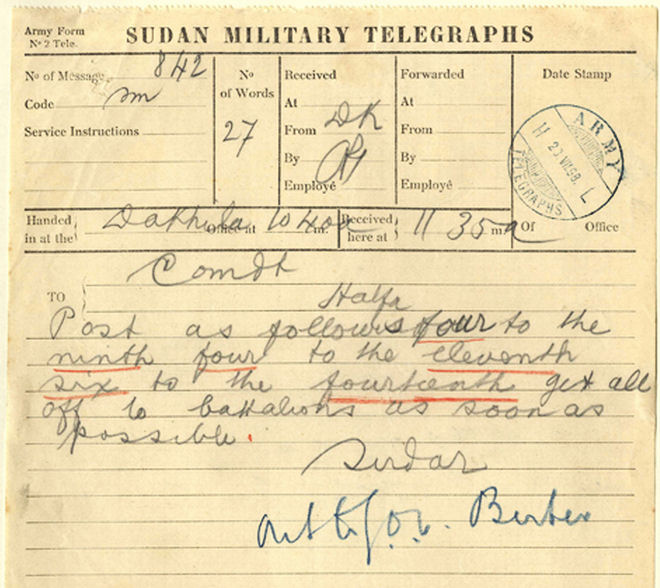
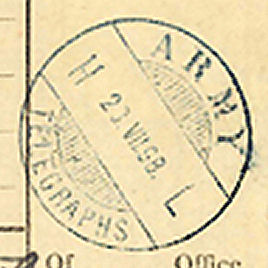
Cancel H 23.VII.98 L
A Telegram Receipt dated 19th November 1899 to Berber.
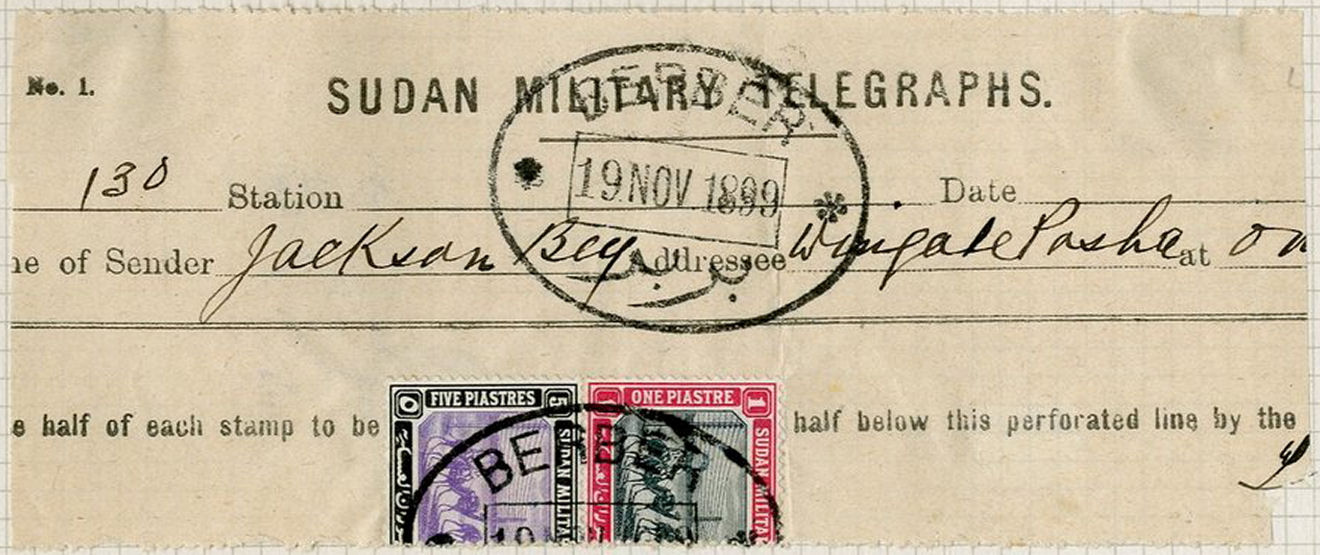
Ex Andrew Higson, courtesy of Spink & Son.
A Telegram Receipt dated 25th May 1900 to Omdurman.
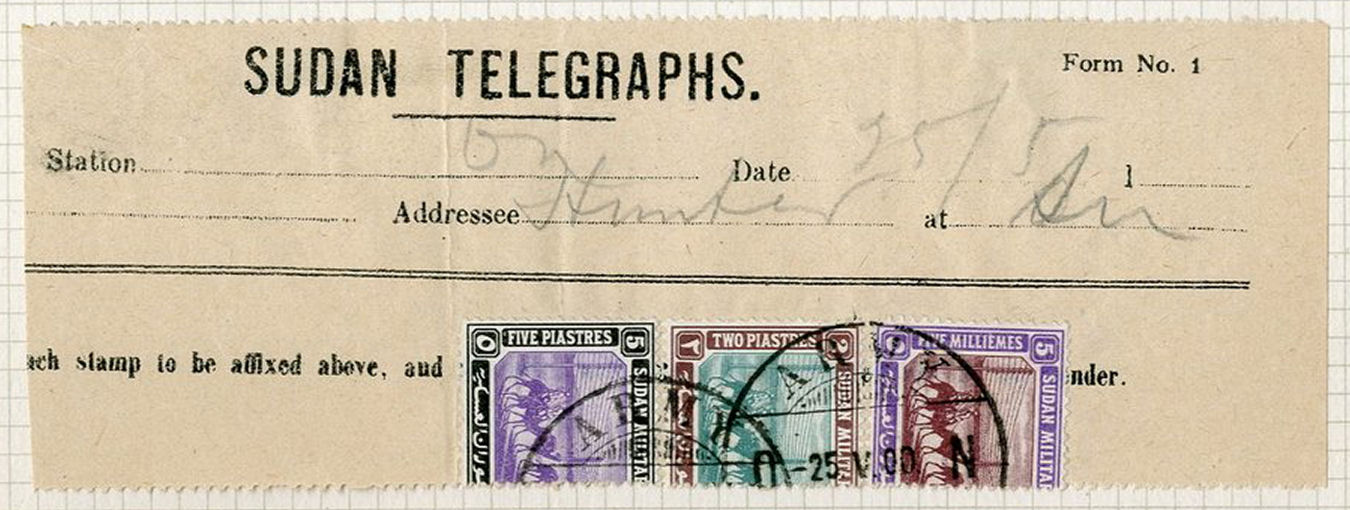
Ex Andrew Higson, courtesy of Spink & Son.
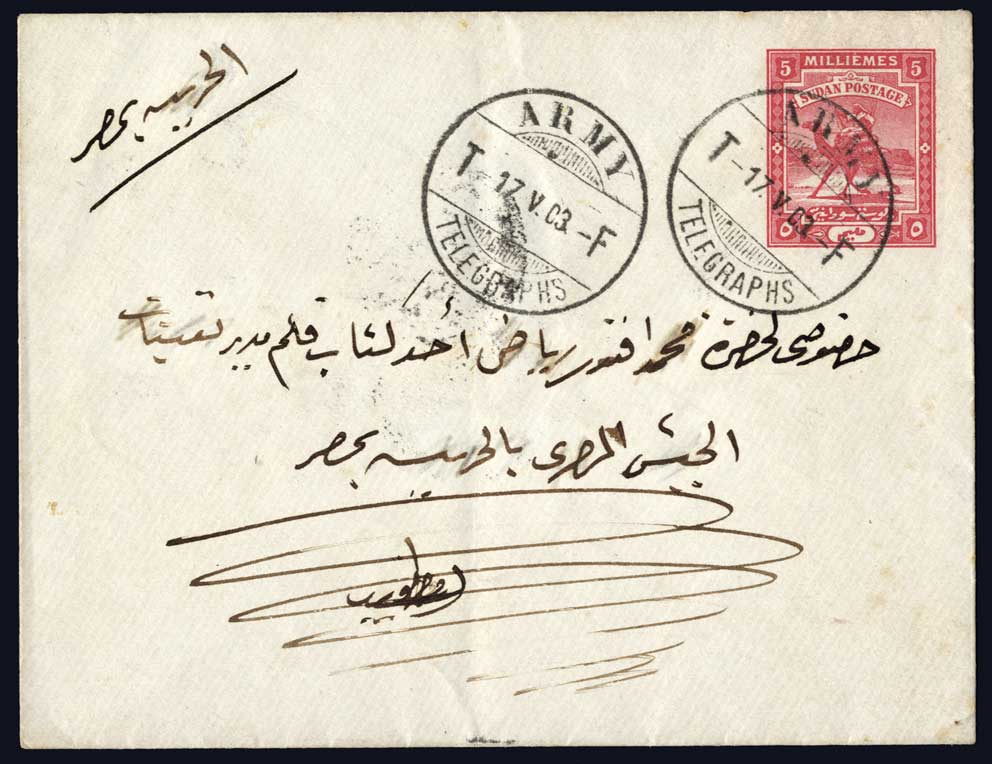
Used on postal stationery, courtesy of Grosvenor Auctions (vendor thought it from Taufikia (later called Halfa), upper Nile)
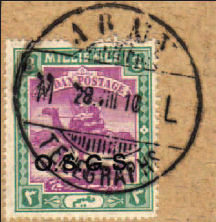
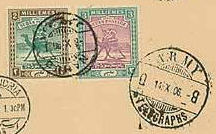 
|
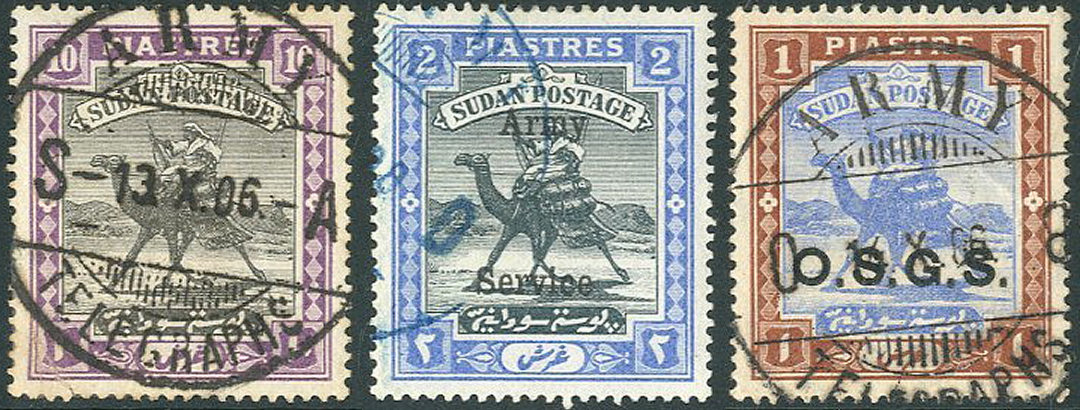 |
| M 28.VIII.10. L Malakal on 3m O.S.G.S. overprinted postage stamp. (Source: Andrew Higson) plus similar on normal stamps. |
S A (Sarras) dated 13 X 06 on 10P, Blue cancel on 'Army Service' overprinted 2P, O B(reversed) (El Obeid) dated 14 X 06 on O.S.G.S. overprinted 1P Images courtesy of Andrew Higson. |
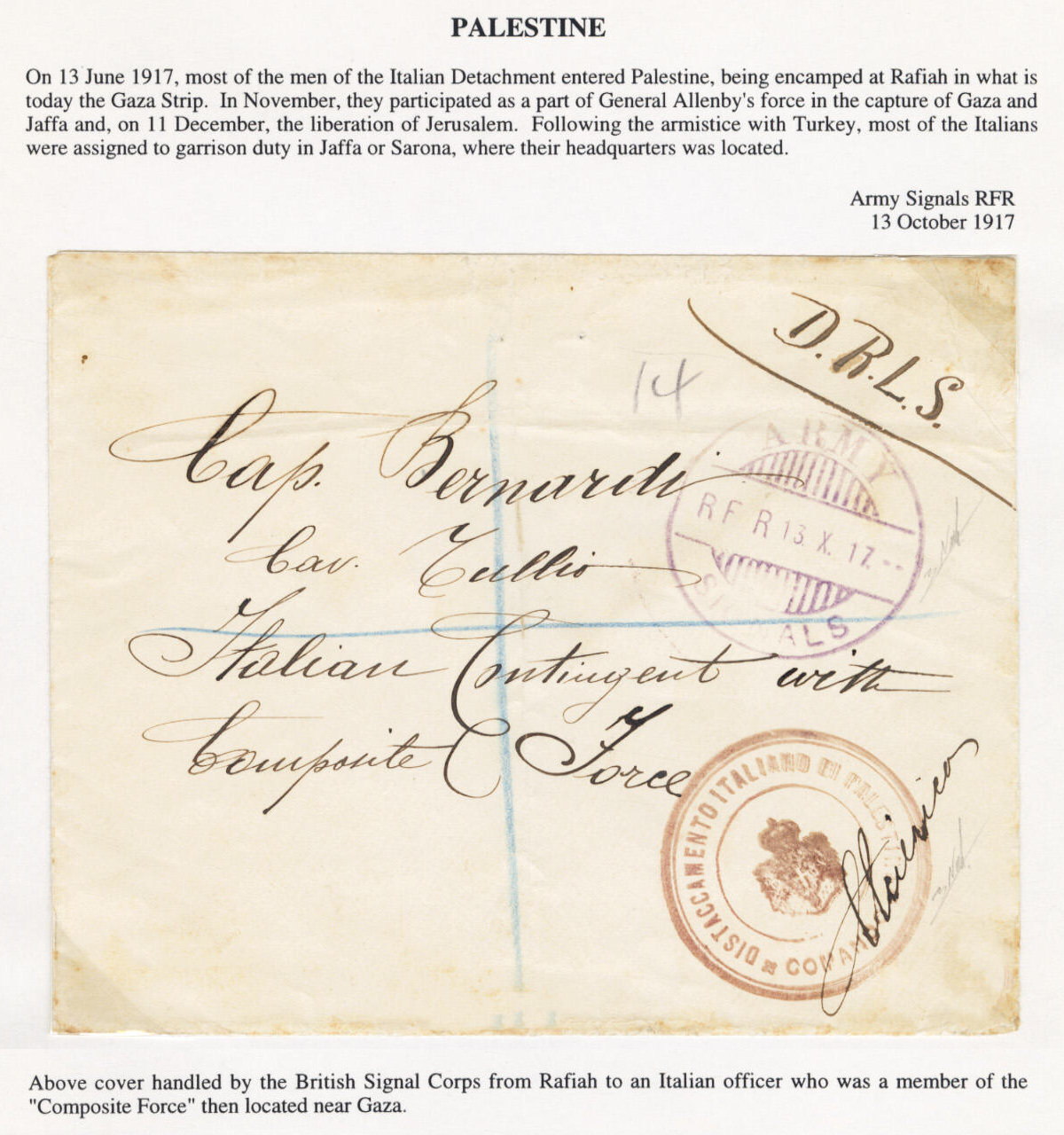
Image courtesy of Cherrystone Auctions
This list is kindly provided by Dr Andrew Higson FRPSL
Adams, R.M. (1970) Through to 1970: Royal Signals Golden Jubilee. Royal Signals Institution.
Anglo-Boer War Philatelist, The (2005) “For the Record: The use of unappropriated die Army Telegraph duties in South Africa (from Jim Buckingham)”, Vol.48, No.4, December, pp.88-89.
Austin, B. (2004) “Wireless In The Boer War”, The Journal of the Royal Signals Institution, Vol.XXV, No., Spring, pp.23-29.
Brown, A.J. (1967) “East African Campaign 1914-1918 (continued)”, Forces Postal History Society Newsletter No.87, Vol.IX, No.7, pp61-67.
Brown, E.G. (1960) “Army Telegraph Cancellations”, The Anglo-Boer War Philatelist, Vol.3, No.2, pp25-27.
Cairnes, Captain W.E. (1899) “The British Army Manoeuvres”, Scribner’s Magazine, January, pp.61-76.
Coles, C.W.E. (1970) “Army Signals ‘NR’ 1917”, Forces Postal History Society Newsletter No. 101, January-February, p.10.
Creeke, Jr, A.B. (1891) “Military Telegraphs”, Philatelic Record, Vol.XIII, No.48, pp.83-88.
Daniel, F. (1986) “Khartoum? Or not Known? That was the Question”, Forces Postal History Society Newsletter No.187, Spring, pp.125-126.
Daniel, F. (1987) “Handstamps of the Royal Engineers Signals in Mesopotamia and Egypt, 1917-1918”, Forces Postal History Society Newsletter No.194, Vol.XX, No.4, Winter, pp.58-66.
Dobbs, M. (1986) “Fake Army Signals Covers From Austria”, Forces Postal History Society Newsletter, No.187, Spring, pp.118-122.
Dobbs, M. (1990) “JER – A Jersey Code or Not?”, Forces Postal History Society Newsletter, No.205, Autumn, p.88.
Drysdall, A.R. (1995) Transvaal: Revenue and Telegraph Stamps. James Bendon Ltd in association with the Transvaal Study Circle: Limassol, Cyprus.
Drysdall, A.R. and Langmead, P. (1996) “Telegraph stamps – an update”, The Transvaal Philatelist, Vol.31, No.2 (118), pp.70-73.
Drysdall, A.R. and Penycuick, K. (1986) “The East Africa Campaign 1914-18: Cancellations on N.F.F. mail”, Forces Postal History Society Newsletter, No.188, Summer, pp.128-131.
Forces Postal History Society Newsletter (1983), “Doubtful Lundy Covers”, No.175, Spring, pp.64-65.
Hippisley, Lt-Col. R.E. (1902) History of the Telegraph operations during the War in South Africa 1899-1902. HMSO: London.
Hiscocks, S.E.R. (1982) Telegraph and telephone stamps of the world: a priced and annotated catalogue: published by the author.
Hisey, R.W. and Bartshe, R.T. (2004) Orange Free State Philately, Vol.2 The Telegraphs. The Philatelic Society for Greater Southern Africa and The OSSEWA Press: Sebring, FL.
Jagger, A. (1962) “Army Signals Express Letter Services”, Forces Postal History Society Newsletter, No.58 (Vol.VI, No.8), November-December, pp.71-72.
Langmead, P. (1975) “Early Army Telegraph Cancellations”, The London Philatelist, Vol.84, January, p.15.
Langmead, P. (1980) “Great Britain Telegraphs”, The London Philatelist, May-June, pp.86-95.
Langmead, P. (1986) “British Army telegraph stamps used in South Africa 1899-1900: A plea for help”, The Anglo-Boer War Philatelist, Vol.29, pp.19-22.
Langmead, P. (1988) “Army Telegraph Cancellations” The Anglo-Boer War Philatelist, Vol.31, pp.34-37.
Langmead, P. (1995) “British Army Telegraphs in the Boer War”, The London Philatelist, Vol.104, p.21.
Langmead, P. (2003) “Army Telegraph Cancellations of the Anglo-Boer War”, The Anglo-Boer War Philatelist, Vol.46, No.4, December, pp.89-92.
Langmead, P. and Huggins, A. (2003) The Telegraph Stamps and Stationery of Great Britain 1851-1954. GB Philatelic Publications Ltd: London.
Lucking, Tony (2002) “Telephony in the Anglo-Boer War”, The Anglo-Boer War Philatelist, Vol.45, No.3, September, pp.58-62.
Millineaux, Lt-Col. (Ret.) D.S. (2004) “Young Harry’s War”, The Journal of the Royal Signals Institution, Vol.XXV, No.1, Spring, pp.18-22.
Nalder, R.F.H. (1953) History of British Army Signals in the Second World War. Royal Signals Institution.
Stagg, E.C.W. (Maj.) (1974) Sudan. The Postal Markings 1867-1970. London: RPSL.
Stanford, Tony (2002) “The Half-Penny QV Jubilee Army Telegraphs Overprints”, The Anglo-Boer War Philatelist, Vol.45, No.1, March, pp.17-18.
Stroud, R. (2004) “Army Telegraph cancellations of the Anglo-Boer War”, The Anglo-Boer War Philatelist, Vol.47, No.3, September, pp.74-76.
Tamsen, E. (1902a) “The fiscal and telegraph stamps of the Orange Free State”, Morley’s Philatelic Journal, Vol.3, No.10, pp.73-75.
Tamsen, E. (1902b) “The telegraph stamps of the Transvaal”, Morley’s Philatelic Journal, Vol.3, No.11, pp.81-83.
The Sphere (1900) “How the telegraph is worked in the field”, March 31, p.314.
Stamps (circa 1985) “More on Fake Army Signals Covers”, p.45.
Ward, G (1953) “Army Signals Service”, Philatelic Magazine, November 6th, p.911.
Watson, G. (2001) “British Second Army, 11th November 1918”, http://orbat.com/site/history/historical/uk/secondarmy1918.html (downloaded 10/01/2007).
A am obliged to the following for helping me with this web-page :
Peter Langmead & Alan Huggins for "The Telegraph Stamps and Stationery of Great Britain 1851-1954" the book that got me started on this.
S.E.R. Hiscocks for the book that filled in many of the gaps: 'TELEGRAPH and TELEPHONE Stamps of the World, a Priced and Annotated Catalogue'.
The Anglo-Boer War Philatelic Society
Orange Free State Study Circle
Transvaal Study Circle
GB Overprints Society
Many illustrations provided by Dr Andrew Higson FRPSL
Illustrations provided by Oscar Van der Vliet
Many illustrations provided by Bram Leeflang
Many illustrations provided by Dr. Mark Gibson
Many illustrations provided by Grosvenor Auctions
Last updated 1st. October 2025
©Copyright Steve Panting 2012/13/14/15/16/17/18/19/20/21/22/23/24/25 except where stated.
Permission is hereby granted to copy material for which the copyright is owned by myself, on condition that any data is not altered and this website is given credit.